#concrete driveways hills district
Text
Building Strong Foundations in the Hills District With Concrete Company Sydney

The Hills District of Parramatta is known for its natural scenic beauty and tight-knit community. Homeowners take pride in their properties and value quality artistry that will stand the test of time.
Installing a new Concrete Driveways Parramatta Hills District is a big decision that requires the right team to partner with. When it’s time for driveway installation or other concrete works in this desirable region, who can residents trust to do the job correctly?
Asking the Right Questions
When launching any concrete project, it’s essential to ask questions. Will the chosen company provide engineered plans and council approvals if needed? How will the job site be prepared, and what equipment will be used? What type of base material and concrete mix is recommended?
An experienced concrete company will be transparent about materials, methodology, timelines, and warranties. Getting the correct answers builds confidence in the outcome.
Quality Assurance from Start to Finish
Careful preparations ensure each concrete project delivers on quality and durability expectations. The concrete Company of Sydney excavates and compacts a suitable road base before laying a proof membrane and reinforcement mesh.
Their experienced team precisely forms and finishes concrete to strict tolerances using professional-grade tools. Comprehensive curing methods protect new concrete, so it reaches maximum strength.
Custom Creations to Complement Any Property
While function is necessary, a new driveway can also improve aesthetics. The Company offers decorative concrete designs using wet-cast stamping, stenciling, coloring, or exposed aggregate finishes.
Exacting replication of natural stone, brick, or tile patterns transforms plain pavements into beautiful home extensions. Patterned borders or logos can strengthen curb appeal for a poolside concrete project. Functionality and visual beauty go hand-in-hand.
Committed to Complete Customer Satisfaction
Beyond the physical work, customers appreciate the company’s ongoing care. Helpful guidance on maintenance keeps concrete surfaces pristine for years. Issues are rarely encountered. But the team stands behind its craftsmanship with multi-year warranties. The team of Concrete Works Outer West Suburbs for same performance and zeal.
A Foundation for Community Spirit
As the Hills District continues growing, a spirit of cooperation endures. Concrete Company Sydney gladly supports local Little Athletics and school fundraising events. Neighbors helping neighbors is a big part of life here.
So, contributing quality concrete works strengthens the tight-knit fabric. Whether beautifying a home, sports field, or community hub — the company’s *work adds lasting value through built partnerships as solid as the concrete they pour.
Concrete Driveways in the Hills
The experts Concrete Company Sydney have answered some common questions about concrete driveways in the Hills District:
When is the best time to install a new concrete driveway?
Generally, spring and autumn offer milder weather suitable for curing new concrete. Summers can be hot and flash-curing, while winter brings rain and colder temperatures that slow the curing process. Consulting a professional ensures the optimal timing.
What concrete mix is recommended for driveway pavements?
A minimum 30MPa compressive strength mix is suitable for a basic driveway. However, adding micro silica or poly fibers creates a denser, more robust, durable, and weather-resistant surface particularly suited to the Hills. It maintains a driveway’s integrity longer.
What maintenance keeps the concrete driveway in great shape?
Basic cleaning with a broom or power washer removes built-up dirt. A mild household cleaner or degreaser does the job for tough stains or grease.
Sealing every 1–2 years protects the surface from moisture, salt, or chemical damage. This simple care extends a concrete driveway’s lifespan by decades.
Concrete Craftsmanship You Can Count On
For any resident embarking on new concrete works in the Hills District, trusting Masta Concrete brings total peace of mind. As a premier Concrete Company Sydney recognized across the region, its trademark is reliability through attention to detail.
Residential and community-focused projects receive the highest quality treatment from consultation to completion. Competitive pricing combined with a 15+ year proven track record leaves no doubt that company concrete lays the most vital foundations for success.
Conclusion
Whether you need a Driveway Installation Parramatta Hills District or a smaller stamped concrete project, partnering with the experts at Masta Concrete eliminates risk and stress. As a concrete company, they understand the unique needs of Hills homeowners and thoroughly enjoy transforming local properties.
To start your new concrete project served with a smile, click here to contact Masta Concrete or call. The experienced team welcomes your inquiry today!
#coloured concrete sydney#concrete driveways#driveway installation#concrete works#concreters near me
0 notes
Text
CONCRETING BLUE MOUNTAINS
Dixons specializes in concreting and we are your top-choice concrete service situated in the heart of the Blue Mountains. Our services extend to all surrounding areas, including Penrith, Western Sydney, Hawkesbury, and The Hills District of Sydney.
Our team of professionals excels in providing top-notch Concreting Blue Mountains services for both residential and commercial needs. Our expertise covers a wide range of applications, including concrete slabs, driveways, footpaths, decorative concrete, and concrete surfacing.
When it comes to concreting, precision is paramount, and we understand its importance. Our commitment to excellence is reflected in our workmanship, ensuring that every project is completed on schedule, with the utmost quality, and at a fair price. You can trust our experience and dedication.
Elevate the appearance of your home, add your unique flair, and optimize your space's functionality starting today!
With a history dating back to 2009, Dixons has established itself as a trustworthy, supportive, and professional name in the industry. Our outstanding Concreting Blue Mountains service is consistently delivered on time and within the allocated budget.
1 note
·
View note
Text
DIXONS CONCRETING - Concrete Repair Blue Mountains
Dixons specializes in Concrete Repair Blue Mountains, and we are your top-choice concrete service situated in the heart of the Blue Mountains. Our services extend to all surrounding areas, including Penrith, Western Sydney, Hawkesbury, and The Hills District of Sydney.
Our team of professionals excels in providing top-notch Concrete Repair Blue Mountains services for both residential and commercial needs. Our expertise covers a wide range of applications, including concrete slabs, driveways, footpaths, decorative concrete, and concrete surfacing.
When it comes to concreting, precision is paramount, and we understand its importance. Our commitment to excellence is reflected in our workmanship, ensuring that every project is completed on schedule, with the utmost quality, and at a fair price. You can trust our experience and dedication.
Elevate the appearance of your home, add your unique flair, and optimize your space's functionality starting today!
With a history dating back to 2009, Dixons has established itself as a trustworthy, supportive, and professional name in the industry. Our outstanding Concrete Repair Blue Mountains service is consistently delivered on time and within the allocated budget.
1 note
·
View note
Text
Dixons Concreting
DIXONS CONCRETING Dixons is your premier concrete service, based in the Blue Mountains and services all surrounding areas, including Penrith, Western Sydney, the Hawkesbury and The Hills District of Sydney.Our crew of professionals lead the way in supplying quality concrete services for your home and business. This includes concrete slabs, driveways, footpaths, decorative concrete, and concrete surfacing.We will get the job done on time, at the highest quality and at the fairest price. Concrete Footpaths Blue Mountains
1 note
·
View note
Text
Get Concrete Contractors In Penrith
Masta Concrete is one of the leading concrete contractors in Penrith. Our contractors are well experienced and work according to client requirements.To know more visit our website.
0 notes
Text
Ultimate Benefits Of Installing Concrete Driveways
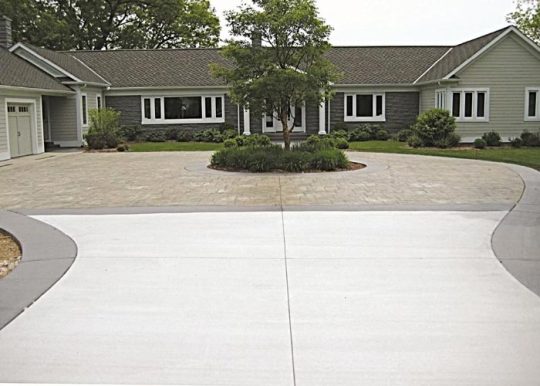
Pleasant and nicely constructed driveways always attract a lot of attention when someone visits your house. At present, most homeowners are going for a concrete driveway because of the various benefits it offers.
Benefits of Concrete Driveway
Durable
In the first place, a concrete driveway provides longevity, which is an essential aspect of driveways. People choose concrete over asphalt or gravel as it is a versatile material not only for driveways but also for floors and porches. You may find these driveways more costly than the asphalt ones, but it is essential to remember that those built of concrete are more durable, look better, and often need less maintenance. These hard and robust driveways can last for more than 20 years with little support. All you need to do is apply a concrete sealer to avoid wearing and prevent stains.
Saves Money
If you find plain, boring, and dull concrete, you can paint it and look beautiful and attractive. You can save the cost of installing concrete driveways in hills district because you can do much of the installation-related work yourself. Concrete driveways will improve both the look and appearance of the property and provide a dry and flat parking space for the car.
Diverse Designs
There are a variety of patterns that you can give your driveway made of concrete. Such patterns will help not only bring visual comfort but will also bring long-lasting consistency to the home. The main advantage of concrete is that it is moulded into any pattern, texture, shape, and colour you want. Pattern stamping is a great way to enhance and add elegance to your ordinary concrete driveway. With the help of pattern stamping, you can create colourful patterns for your driveway and look like tile, brick, or padded stone.
The aspect you need to make sure is that the concrete will be of good quality before you go for a concrete driveway. You should take note that the surface of the driveway would have a cross-drop to help the water drain away. It should also be free of any low area that prevents water from accumulating.
Maintenance of a Concrete Driveway
To ensure the long life of your concrete driveways, it is necessary to keep them clean and sealed. You may use an excellent scrubber to clean the driveway and a concrete seal to add a layer of protection. Once a year, using a concrete sealer can provide excellent protection for your driveway. Stains, if any, must be cleaned immediately upon notification. Drop sand on the driveway to provide traction. Concrete driveways in hills district are a practical choice for homes and can make them look attractive depending on the taste, preference, and budget of the individual.
If you need a driveway that lasts as long as your home, a driveway that matches your beloved home's colour and style, or wants a driveway material that is versatile and easy to maintain, you can never go wrong with concrete. It has all the best properties of all the other pavement materials on the driveway, and much more.
0 notes
Text

Oscar Niemeyer Defined Modern Brazil. Now, an Artist Is Rethinking One of His Houses.
Set against the dramatic hills of Rio de Janeiro, Adriana Varejão’s recently renovated home brings the architect’s vision to startling new life.
By Thessaly La Force
Aug. 17, 2018
DRIVING UP THE STREET — which, this being a nice residential neighborhood in Rio de Janeiro, is a fortress of fences and high-level security gates — you nearly miss it. Nestled in the verdant Jardim Botânico district — where toucans fly from tree to tree and monkeys can be heard laughing in the afternoon — sits an elegant house designed in 1969 by the great Modernist architect Oscar Niemeyer. It is a stack of white boxes along a hilltop, all right angles against the lush green flora of Brazil, with a spiral staircase to reach the highest box, which stands like a turret overlooking the city. The cliffs that encircle Rio tower dramatically above, beyond which rise the outstretched arms of the city’s Christ the Redeemer statue.
Niemeyer originally designed the property for his wife’s sister, Carmen Baldo. Seven years ago, Baldo’s children sold it to the artist Adriana Varejão and her partner, the film producer Pedro Buarque. Despite its Modernist allure, the house was not an easy sell. The glass walls between the terrace and the living room no longer opened. The ceramic steps and floors that blanketed the property looked dingy. The concrete railing — concrete is cheap, and Niemeyer’s sister-in-law wasn’t wealthy — had failed to acquire a patina. The narrow driveway alongside the house leading to the garage was impossible to navigate because there was no room to turn around. Downstairs, where the bedrooms had been placed along a looming corridor, was dark and gloomy. To fix these problems, the couple embarked on an ambitious five-year renovation that honors the legacy of Niemeyer and the promise of Brazilian Modernism perhaps even better than his original design. In recent decades, Modernism has become solely an aesthetic, divorced from its original intentions. And so, more unusual than the fact of Varejão and Buarque’s restoration is how well it pays homage to Niemeyer’s heritage and architectural philosophy — his lyrical and idiosyncratic sensibilities, scaled perfectly to the mountainous terrain, with large open spaces where the indoors blends seamlessly with the outside.
OSCAR RIBEIRO DE Almeida Niemeyer Soares Filho, born in 1907 in Rio de Janeiro, was one of Brazil’s greatest architects, and certainly its most famous. No other hand has done as much as his to shape the dimensions of the country, reflecting back its primitive beauty — the roiling depths of the sea, the undulating curves of the shoreline, the dense jungle — in its buildings. Along with his teacher-mentor, the architect and urban planner Lúcio Costa, and the landscape architect Roberto Burle Marx, Niemeyer was part of a group of Brazilian Modernists who believed in constructing a nation that would usher itself into a new era of equality and prosperity. All three, but especially Niemeyer, were deeply influenced by the French architect Le Corbusier. Like Le Corbusier, Niemeyer was partial to working with reinforced concrete, the flexibility and sturdiness of which helped his structures achieve the poetic, biomorphic forms that came to define his work. Just look at the hovering saucer of the Niterói Contemporary Art Museum(1996), perched at the edge of Rio’s Guanabara Bay, or the Cathedral of Brasília’s (1970) brilliant white crown of spears, which seems to sprout from the earth. As Niemeyer famously wrote in 1998, “I am not attracted to straight angles or to the straight line, hard and inflexible, created by man. I am attracted to free-flowing, sensual curves. The curves that I find in the mountains of my country, in the sinuousness of its rivers, in the waves of the ocean and on the body of the beloved woman.”
Niemeyer’s legacy rests largely in his creation of the city of Brasília in the late 1950s, which he conceived with Costa, at the behest of Brazil’s president at the time, Juscelino Kubitschek, who had campaigned with the slogan “Fifty years’ progress in five.” Kubitschek was an ambitious leader who believed Brazil could industrialize at lightning speed, shed its colonial past and compete in the global economy. Located hundreds of miles inland, Brasília was erected in just three and a half years at an exorbitant cost (estimates put it at the tens of billions in today’s dollars), replacing Rio as the country’s capital in 1960. Niemeyer, who found inspiration in Le Corbusier’s unrealized Radiant City, a utopian concept where life was ordered by design, wrote: “The seat of government must be established in the heart of Brazil’s vast territory, so that it surveys the whole national panorama, so that it will be within reach of all the classes and all the regions.” But once made, the large plazas meant to stimulate civic life remained empty. The thousands of workers who had traveled from the less industrialized parts of the country were left stranded in the low-income housing, or favelas, that had been hastily erected during construction. In 1964, a military coup supported by the United States government changed the course of the nation forever. Politically to the left of the new military regime, Niemeyer moved to Paris in 1967. His career suffered. Over the decades, architectural Modernism became less popular, perceived as too dogmatic — but Niemeyer continued to work, finding newfound appreciation in the years before his death at the age of 104 in 2012. Some of his most stunning works are in Brasília, including the Supreme Court (1958-60), whose columns of concrete clad in white marble echo the fluttering of a sheet in the wind. Ultimately, though, Brasília’s failure overshadows its monumental promise.
Brasília is also where Varejão spent the beginning of her childhood. The artist was born in Rio, but her parents moved to the city when she was 2 years old. Her father was a pilot in the air force. Her mother worked in public health as a nutritionist in Sobradinho, one of the several satellite cities ringing Brasília’s perimeter. Accompanying her on hospital visits, Varejão witnessed firsthand the inequality Brasília created. “The future never happened,” Varejão tells me, “Brasília left us with some very nice buildings — I’m not saying they aren’t important — but it was at a very high cost.”
ONE MAY AFTERNOON, Varejão, 53, welcomes me to her studio, located five minutes from her home. It is autumn in Rio, though it feels like spring until I sense the sun hastily setting over the horizon. Varejão is preparing for a summer show with the Victoria Miro gallery in Venice, as well as her largest and most significant show to date with Gagosian Gallery, to be held in New York City in early 2020.
She is at work on some large-scale paintings inspired by Mexican ceramic tiles (talaveras) as well as a series of sculptures made from polyurethane, painted to resemble tiled walls but whose insides are revealed as bloody innards. Her process for the former involves pouring a mixture of glue and plaster into a flat, lipped canvas, which is then left to dry over several days. The plaster cracks naturally, and Varejão paints them in a monochromatic white, coloring the edges a claylike shade to lend them the appearance of cracked terra cotta. In previous work, Varejão has created abstract, vaguely discomfiting images on the cracked canvases — on others, the distinctive blue patterns of traditional Portuguese tiles (azulejos). To Varejão, the azulejo is a metaphor for the complicated history that defines Brazil; it is hers to manipulate in various formations and with various patterns, at once beautiful and familiar, but also deeply disquieting.
Varejão is one of Brazil’s most important living artists. She is primarily a painter, but she has worked in other mediums such as photography, video and sculpture. Her work is, in many ways, in dialogue with that of last century’s Italian painter Lucio Fontana, who famously took the scalpel to the canvas and slashed it — “Art dies but is saved by gesture,” he wrote in 1948. If Fontana alluded to pain with his holes and cuts, then Varejão takes the symbolism one step further, illustrating violence through literal renderings of blood and gore.
At Varejão’s urging, I visit the São Bento Monastery, a Benedictine abbey completed in 1671, located across the city in downtown Rio. Inside, its Baroque details — ornate gold-leaf gilding and Rococo painted tiles — are transportive, delivering one to a much older Brazil. But after witnessing the violence rendered by Varejão’s brush, I cannot help but see this other Brazil as tainted with the complicity of colonialism’s brutality. The strange geometry of Brasília is a world apart. Niemeyer’s idealism — his belief that architecture could create a world that was post-race and post-class — was naïve, perhaps, but understandable. How else can a nation propel itself forward after having been so carelessly used — stripped and mined, bought and sold, without any consideration for anything but profit? The clean lines and syncopated curves of Niemeyer’s architecture seem necessary compared to Baroque’s dense hierarchy.
TODAY, THE CARMEN Baldo house is no longer a relic. In a dramatic reconfiguration, Varejão and Buarque decided to move the garage underground, which required digging deep into the hill. Even more flamboyantly, they purchased the property next door and demolished it, which allowed them to build a pool, a lush outdoor living space, a patio and a larger garden. They cut a large circular window into the living room so that it would overlook the pool, providing a sense of continuity between the two spaces. There are smaller touches as well: Though they kept the original color of the marigold yellow Formica in the kitchen, they knocked down the back wall, echoing the fluidity between the living room and the front terrace. Niemeyer understood the beauty of Modernism in Brazil’s climate, and his open-air plans integrated perfectly with the textured scenery of the tropical outdoors. Lastly, all of the ceramic flooring as well as the terrace railing was replaced with Brazilian soapstone, its dark mossy green jagged with electric white stripes.
That night, I am invited to dinner by Varejão and Buarque. I’m curious to see the house as it was intended: full of people, made imperfect by a kind of kinetic carelessness. When I arrive, open bottles of wine sweat in an ice bucket beneath a Lygia Clark painting. I sag into a leather chair by Lina Bo Bardi. Varejão serves a traditional meal that we eat on a large dining table made by Sergio Rodrigues — picadinho (beef stew) and baked fish, rice and beans, a banana purée, fried quail’s eggs, and chopped cabbage from the countryside garden of Varejão’s friends, the filmmaker Walter Salles and his wife, the artist Maria Klabin. Varejão and Buarque’s friends are artists, singers, musicians, writers — we discuss everything from João Guimarães Rosa’s Joycean novel “The Devil to Pay in the Backlands” (1956) to the pessimism that surrounds Brazilian politics today. Modernism may have become an empty expression of bourgeoisie taste, but here it feels reinvigorated, charged. I’m told many times that I must visit Brasília, which is less than two hours away by plane.
Instead, the next day, I go to the house Niemeyer built for himself in Rio in 1953. It is past Leblon, the wealthy beachside neighborhood, in Barra de Tijuca, another wealthy beachside neighborhood. On my winding drive there, I glimpse the favelas. This is Rio, too, where immense poverty abuts immense wealth. Niemeyer was disdainful of money, even if he worked with those who had it. He rarely wrote about the private residences he designed, and he allowed only a handful to be illustrated or listed — as is the case with many prominent architects, he largely considered these designs exceptions, favors or one-offs. But his own house, with its views of both the mountains and the ocean, is canonical for its elegant curves and its cloudlike roof that sweeps across the horizon. To Niemeyer, light was a form of pleasure.
The house now sits unused but open to visitors; two volunteers from the Oscar Niemeyer Foundation inform me that the furniture is contemporary. That Niemeyer couch was his. But the fabric is soiled. The books downstairs belong to his personal library. But the pages have warped from the humidity. The pool, less a kidney and more of a chickpea, is filled with leaves. I feel like someone discovering a bronze Roman statue at the bottom of the Aegean Sea, its beauty disguised by oxidization, its form marred by barnacles and tangled seaweed. As I flip through a pamphlet laid out for visitors, I see pictures of the house sometime in the 1950s, filled with guests at a party. They are nattily dressed, laughing, with cocktails and cigarettes in their hands. They look as if they are still waiting for the future to arrive.
#Rio de Janeiro#Architecture#Oscar Niemeyer#Roberto Burle Marx#Modernism#Casa Baldo#Thessaly La Force#Brazil
19 notes
·
View notes
Text

Thomas Valva, a third-grader at East Moriches Elementary School who had autism, was found unresponsive at his home on Bittersweet Lane in Center Moriches on Friday, January 17, and was later pronounced dead at Long Island Community Hospital.
Authorities alleged his father, 42-year-old NYPD Officer Michael Valva, frequently abused the boy and forced him and his 10-year-old brother Anthony to sleep in the garage in frigid temperatures without blankets or pillows.
"Thomas Valva was subjected to freezing temperatures in the home's unheated garage overnight when the outside temperature was 19 degrees," said Police Commissioner Geraldine Hart, adding that the boy's temperature was just 76 degrees when he arrived at the hospital.
Michael Valva and 42-year-old Angela Pollina are now charged with second-degree murder with depraved indifference to human life, and both have pleaded not guilty.
The Suffolk County Department of Social Services confirmed previous contact with the family after allegations of child neglect. Safeguards were put in place, and Commissioner Frances Pierre said a full investigation is underway to ensure protocols were followed.
Pierre issued the following statement:
"The Department of Social Services is heartbroken by the passing of Thomas Valva. Department personnel are continuing to provide all available information on this matter to law enforcement and will continue to cooperate fully throughout the investigation. Suffolk County Child Protective Services has had involvement with the Valva/ Pollina family. Petitions for child neglect were filed in Suffolk County Family Court in 2018. Safeguards ordered to protect the children included court-ordered home supervision for a period of one year, Orders of Protection for the parents to refrain from harmful behaviors towards the children and mandated participation in a Positive Parenting Program had been put in place. Subsequent to the expiration of the order of protection, CPS investigated additional complaints relating to the family. DSS is formally reviewing the management of the case to ensure that all protocols were followed in accordance with the law. Due to confidentiality mandates and the nature of this ongoing investigation, the Department cannot comment further at this time."
Police say Michael Valva had called 911 and said his son had fallen in the driveway while waiting for the school bus and was unconscious. When police arrived, Valva was performing CPR on Thomas in the basement.
"We determined Thomas was never in the driveway that morning, and he suffered head and facial injuries that were not consistent with the father's account," Hart said.
Police made the arrest after reviewing home security surveillance video, and prosecutors say each room of the house had a camera that was labeled. They said the camera in the garage was low to the ground and pointed toward the floor with the label "the kids' room."
They said video from the two previous nights showed Thomas and Anthony sleeping on the garage floor, shivering.
Assistant District Attorney Laura Newcombe said during the arraignment of Valva and Pollina late Friday that audio files recovered from the home recorded the couple discussing the fact that the child was suffering from hypothermia, had been washed with cold water, couldn't walk and was "face-planting" on the concrete on the morning he was killed.
Suffolk County District Attorney Tim Sini said he had listened to the audio himself.
"I can't describe it in words," he said. "The depravity of these defendants is shocking."
The child's mother, Justyna Zubko-Valva, said her son was a happy boy who loved playing outside. She said the abuse was prevalent.
"Nobody did anything," the boy's mother Justyna Zuubko-Valva, said. "I tried, I fought so hard to, you know, fought for justice for my children...It shouldn't get to the point that, you know, my son lost his life to actually for somebody to do something."
Viewings will be held Wednesday from 2 p.m. to 4:30 p.m. and 7 p.m. to 9:30 p.m. at the Mangano Family Funeral Home on Deer Park Avenue in Deer Park. A funeral will be held at 9:30 a.m. Thursday at St. Elizabeth of Hungary Roman Catholic Church on Wolf Hill Road in Melville, with burial to follow at St. Charles Cemetery in East Farmingdale.
Authorities are still investigating whether a 6-year-old brother was also abused, and if Pollina's three children -- 11-year-old twins and 6-year-old -- had suffered any abuse. The children are now at a safe location.
The defense denied the accusations, calling them pure speculation and maintaining Valva's innocence. He was remanded without bail.
Valva, who joined the NYPD in 2005 and is assigned to transit, has been suspended without pay, the department said.
1 note
·
View note
Text
Peter Pichler completes angular concrete-and-glass villa in Italian vineyard
The folded form of this villa, designed by Peter Pichler Architecture for the owners of a vineyard in South Tyrol, is intended to merge with the existing landscape and form a shield around its central courtyard.
The Milan-based studio won an invited competition in 2018 to design the property, which replaced an existing structure within the Kastelaz vineyard in the Termeno district in Italy.
Kastelaz Hof was designed by Peter Pichler Architecture and built on an elevated site
The estate's owners wanted to build a contemporary home on the elevated site, which enjoys spectacular views of the surrounding Alpine landscape.
The design of the house responds to its setting, nestled among trees and vines and looking along the valley towards Lake Caldaro.
The structure has a low-lying form that overlooks the town
"The geometry of the villa evolves from local site conditions," the studio said. "It creates a flowing and harmonious transition with the landscape and is barely noticeable from the nearby village."
The angular structure appears to emerge from the earth of the hilltop, with its sloping walls connecting seamlessly with the roof.
The studio used glass and concrete across the exterior of the Kastelaz Hof
The horseshoe-shaped plan wraps around an internal courtyard that is protected from the winds funneling up the valley from Lake Garda to the south.
The building's external surfaces evoke the tone and texture of the chalk-stone retaining walls found throughout the surrounding vineyards.
Read:
Peter Pichler designs Tree House hotel rooms for forest in the Italian Dolomites
A large driveway connects with a cave-like garage embedded in the sloping terrain, while a set of stairs leads up the hill to the house's main entrance.
Inside, the house is arranged as three connected wings. One wing contains the main living space with the kitchen and dining area alongside, while the other two wings accommodate bedrooms, including the large main suite.
There is an outdoor courtyard at the centre of the villa's horseshoe plan. Photograph is by Samul Holzner
Full-height glazing along with carefully positioned windows and skylights ensure the spaces feel bright and connected with the views.
"The wide glass facades are designed to frame and highlight the surroundings and to let the landscape enter the indoor spaces while maintaining internal privacy," the studio added.
The studio applied a light and airy look throughout the interior
The architects chose materials that create a warm, yet simple and minimal atmosphere. A palette featuring concrete, terrazzo and wood ensures there is consistency between indoor and outdoor spaces.
In addition to the central courtyard, a large terrace on the upper floor provides an alternative space for outdoor relaxation and is connected to a mezzanine lounge.
Floor-to-ceiling windows provide views out to the landscape
Architect Peter Pichler and his wife Silvana Ordinas established Peter Pichler Architecture in Milan in 2015.
The studio's previous projects include a hotel in a forest featuring pointed cabins set among the trees, and a mountainside restaurant with three cantilevered gables that project out towards the views.
Photography is by Gustav Willeit unless stated otherwise.
The post Peter Pichler completes angular concrete-and-glass villa in Italian vineyard appeared first on Dezeen.
0 notes
Text
Suburban Ennui
In the winter, we cannot recognize ourselves dressed in our mother's lace. Shrouded in gold, and you in pearls, we’re whisked away by our fathers cinching, leather grips to the old fishing district. With its nose turned up high on the hill, looking down at the rest our desolate, iced-over tourist town, sits the yacht club. A setting as lively in the summer as it is in winter, where the events held to keep the ennui at bay are disguised as something more-something meaningful. Every wine tasting night, every father-daughter dance, every Christmas dinner all just excuses keeping the townsfolk from their own perilous restlessness until the sun shines over our brimming little beach town again. It’s a place where you and I have to play pretend just to survive. Exploited and used by our families like props and trophies, we’re paraded around like cattle, forced to carve out our widest smiles for the wolves dressed in bow ties and boat shoes. I swear I can still feel the sting, well into the warmer months, from where the old widows slap our hands and hiss “stupid girls! Not like that, smile with your teeth!” Our cheeks would burn, abashed and sore. Nevertheless, we’d comply, too afraid of the consequences that would ensue had we not. With our bare bones exposed, the wolves could carry on gawking, our fathers bragging, and our mothers could breathe poised sighs of relief knowing their daughters were safe for another season.
“There’s something unsettling about their eyes,” You declared one night at a dinner dance, cookie swap, fundraising event or whatever it was at the time. Sometimes we found refuge, hugging our knees underneath tables devoid of any place cards or centerpiece. “It’s like staring into the very nights that claimed their lovers.”
“The widows?”
“If you catch a close enough look, you can see them capsize.”
In spring, we shed our skin between the trees and wash away girlhood in the creek. The world around us is still aside from the trembling in our knees, scraped and laced with diamond pavement and concrete. We’d welcome the season's respite with offerings carried away on the backs of bugs. We’d feast on blood oranges, rip them apart with our nails and wince at the metallic taste. Still, we couldn’t get enough. The entire town couldn’t get enough. The widows thaw back into witches, the wolves suspiciously retreat. Spring was a renaissance, and from high up in the trees-our kingdoms away from home-we had front row seats. I wore mud smeared cheeks well, you wore grass stains better. We used the threads from the tears in the knees on our jeans to reinforce our own loose threads, we used our t-shirts as tourniquets. Naked and raw, running in the woods like infants who just discovered their legs capabilities, all we had to fear then were our mothers. Still numb from the winter, the wolves would run off with their rabbits, leaving them empty nesting, scathing and bitter. They wouldn't like what we got up to in the forests.
“My mom is gonna kill me,” you’d say, with dirty hands mimicking a knife to your throat.
“Don’t joke like that.”
The response to my demand did not pass through your lips. It was not your voice who carried the question, nor was it one that you and I recognized. But we could recognize the feeling it had brought with it, and the butterflies who made their cocoons in the pits of our stomachs began to beat against our insides.
“Who’s joking?”
Come summer, our town becomes overrun like the invasive plants down by the marshes, the ones that swallow you whole lest you got too close. We could never see the tourists coming. It would start with the faint footsteps in late May, only to be heard in symphony with the night owl’s cries. Never bring it up at breakfast, the point would be moot. Even when they get closer and the footsteps began to sound like a stampede, nobody else seemed to notice. Or if they did, they’d never admit to it. We could never see the tourists coming, all we could do was fall asleep to sound of their deafening march and wake up on June first to crowded beaches and congested streets. The mosquitos came with them, moving through the heavy humidity in thick sheets. Bug spray was never enough, but you and I were smart enough to even bother with that stuff, and the witches in the lighthouses were too wise to. We’d make our way through the crowded streets-hiding from more than just the sun underneath the wide brims of our hats-to find them. We’d find them, only after ascending the rusty lighthouse stairs for what seemed like an eternity, concocting spells in the same, casual way that old ladies like to bake. Mud and moss, moth wings and cicada shells, crushed berries that looked less like berries and more like blood. Things we couldn’t quite explain.
“It’s protection,” explained one witch.
“Keep it close, and cherish it like your youth,” said another.
They only ever spoke in metaphors, riddles, or in abstract language that only elicited quizzical expressions from you and me. We’d thank them all the same.
On our way back to town, we’d take the detour route to test out our new protection spells. Far off underneath the canopies of the red cedar swamp where they gathered to store the blood they collect, the mosquitoes avoided us like a plague, disgusted by the vials that hung around our necks.
“If you listen, I mean if you really listen closely and if you stay quiet enough…” You grabbed my hand, trying to quiet me and at the very moment our skin made contact, a blinding thread of heat lightning weaved its way across the sky. Followed by a clap of thunder with all too perfect timing. You simply carried on with what you were trying to say and to this day, you’ve never said a word about the electric hum that followed us home that evening.
“...you can hear the mosquitos whispering.”
I heard them cursing the witches, telling secrets...and I could’ve sworn I heard something about love.
Then came fall, when we’d sit in the graveyards at sunset. There, we’d count the number of new names and unmarked graves, taken by the bugs or the masses. We could never see them coming, but from the graveyards, we had a perfect view of the bridge that guided away the tourists. Oh, how we loved to watch them leave.
“They’re the lucky ones” you’d say.
“Sure are...” I’d solemnly agree, and we’d carry on watching and living vicariously.
You’d inform me of the brightness in my eyes quickly fading, and I’d inform you of the sorry state of your sun-kissed cheeks. As the sun went down over our little beach town, I’d study you closely, thinking in blueprints and escape plans. The trees would shed their own skin, and bend to the will of the wind like skeletons. While the wolves would reemerge, well rested and mean, the witches snuck goodbye letters into our hiding spots by the creek. Ignoring the weather reports that kept our fathers glued to the TV, we’d judge how bad the winter would be by how hungry the wolves were. Our mothers were always far too busy to even think of winter, blind to any impending doom ahead. They frantically packed and prepped our oldest siblings for university, getting ready to send them off, over the bridge with the last of the tourists.
“They’re the lucky ones…” I’d whisper, waving goodbye at the edge of my driveway.
“Sure are…” you mouthed from across the street.
As soon as the minivans were out of sight, as soon as our mothers retreated and our fathers were back inside glued to their TVs, we’d make our way to the creek one last time. Before the ice came to claim it, before our mothers could catch on to where we disappear to in the spring, we retrieved the letters-left by witches and signed by widows, apologizing for what they might do come winter-and left in haste, without any trace to ever tie us to having been there. Come the fall, we fall asleep clutching letters left by witches and signed by widows, holding on to empty vials of what was once protection spell and gripping the notion that one day, we’ll escape ourselves.
“Such imaginations those girls have…”I heard my mother whisper into the telephone one night as she poked her head into my bedroom.
“Isn’t it something?” your mother asked and answered into the receiver.
Pretending to be asleep was both a natural talent and a survival tactic.
#creative writing#twcprose#prose#creative writing prose#suburban gothic#suburban ennui#regional gothic
15 notes
·
View notes
Text
NATURAL STONE EXPORTER-BHANDARI MARBLE GROUP
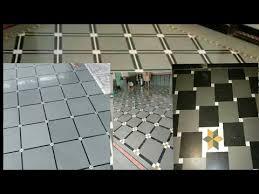
We house the beauty of natural stone. The most underwhelming aspect of a house is the flooring. It determines how vibrant and comfortable your home is. Natural stone has different characteristics that make it stand out from other materials. Some people prefer using tiles that provide a better visual act than longevity, while others look for strength in the flooring material rather than being merely eye candy.
It is advised by various architects to use natural stones instead of artificial flooring to get the benefit of magnificence and stability.
Bhandari Marble Group is the leading exporter of all kinds of natural stones. Here we are presenting some most common natural stone which we regularly export to our clients.
KOTA STONE
Kota stones are fine-grained naturally available limestone. Quarried at Kota district of Rajasthan, India, it is one of the most preferred building stone for exteriors, driveways, pathways, corridors, balconies, etc. It also finds its application in flooring of chemical industries for its inertness towards a large number of chemicals. These stones are available in different finishes (Smooth and rough) and in wide variety of earthy colors with brown being the most popular. It’s also available in Black, Beige, Grey and Pink. It outstand other stones in similar applications for its homogeneity, hardness and non-porous properties.
Kota Stone Slabs
The slab should be of desired quality, hard, dense, homogeneous and free from any cracks, decay, weathering, etc. It could be either hand or machine cut for the required thickness. The exposed face of slab should be polished before being placed at site and also the contractor shall get the slab sample approved by the concerned Engineer.
Advantages and Disadvantages of Using Kota Stones
Advantages
Kota Stones have wide application in exterior works for its non-porous, non-absorbent, tough and homogenous properties and is an excellent building stones for both humid and freezing regions.
Availability of the stones in slab and tile form makes it convenient to achieve different pattern of flooring.
It gives rich aesthetics to both interior and exterior flooring and is cheaper than other stones used in similar application.
Disadvantages
Unlike granite or marble Kota stone slabs are not available in bigger sizes. This is because of its fragile nature.
On a longer run Kota stones flake out. However if well maintained and polished regularly the flaking of stones can be intercepted to a greater extent.
SLATE AND LIMESTONE
Slate and limestone also have water in common, at least when it comes to their formation. Slate is found in the ocean; likewise, limestone is found anywhere an ancient sea existed and can even be comprised entirely of marine fossils. Limestone’s are sedimentary rocks that form from the layering of silt and organic matter over time. The pressure and heat from the accumulation of layers results in chemical reactions that harden the sediments into solid stone.
Limestone certainly has many faces, but it finds a spot in our hearts for its uses in indoor and outdoor, commercial and residential applications. Its muted tones, whether polished or honed, are fit for bathrooms, fireplace facings and mantles, countertops, and flooring. Limestone is very porous, so it doesn’t turn aside stains as easily as some other natural stones; therefore, when it comes to countertops and flooring, it must be finished and sealed properly or placed in areas that are less active. Limestone slabs and tiles are also suited for landscaping applications in patios and walkways. They are especially eye-catching when defining garden borders, as both a salute to nature and a nod to limestone’s nutritional pedigree.
Dependability
Compared to many other building materials, limestone touts dependability like no other. This characteristic can be demonstrated through the detailing of its use throughout history. Although it may not be a well-known fact, limestone has been used as a building and surfacing material for centuries.
Versatility
Limestone can be used on its own in panels for flooring or other surfacing purposes. Additionally, while it is considered to be extremely durable, as touched on above, it can still be crushed to be used in cement for use in buildings and other structures.
Cost Effectiveness
Limestone is shaping up to be a top contender on the list of possibilities. Not to mention we aren’t even done covering its advantages!
Where Is Limestone Best Used?
As touched on above in explaining its advantages, limestone is an extremely versatile material. It can be utilized in a number of different ways and circumstances. It can be used in and of itself in the form of panels for flooring, walls, etc. It can also be crushed and used in cement for use in buildings and structures. Additionally, it can be shaped to make decorative elements to be place within your home or business. As you can tell, limestone is extremely versatile and thus able to be used in a number of different circumstances. Hopefully you’ve been able to determine where and how you would utilize it depending on your need!
The addition of natural stone in your outdoor living space is a simple one that can be both functional and beautiful. Pebbles and cobbles are a great way to achieve these benefits and prove that small additions can go a long way toward giving your space a polished look.
Where can be Pebbles Applied?
Pebbles can be applied in a number of ways for an immediate improvement to the overall look of a design. Around patios or walkways, they can create a border that restrains weed growth. They can help to regulate the soil from temperature extremes as well as prevent the washout of tender plants, shrubs and trees or even erosion of slopes and hills by creating a protective barrier or ring to control the rate of water absorption into the soil.
Pebbles Are The Natural Beauty
Pebbles are an inexpensive way to highlight foliage, add personality to a water feature, or lend a splash color where it is needed to liven up an older hardscape. Pebbles create a finished look – in plant containers, raised gardens, and borders, they are an attractive, natural addition with genuine authenticity. Bhandari Marble Group offers polished pebbles in an assortment of colors and sizes for a refined look.
What are the Cobbles?
Cobbles are a charming way to create useable walkways and paths. As a winding surface through a vegetable garden, a pretty border, or as a little patio for your fire pit, cobbles are an easy way to add a defined space that will keep weeds at bay and give you a clean surface to walk on! Best of all, they are typically set in sand or crushed stone, which means they can expand and contract with temperature variations and, unlike a piece of concrete, won’t crack as they move.
Cobbles the Perfect Stone for House Inner & Outer Beauty
Changing the look and functionality of your outdoor living space is easy with just a few little upgrades. Pebbles and cobble stones are indeed little in size, but they pack a big punch when it comes to livening up your landscape. They will enrich the environment by introducing a natural stone that will blend into its surroundings with casual grace– granite cobbles or sandstone, MSI offers a variety of shapes and finishes to fit your style.
0 notes
Text
How do You Find A Quality Contractor for Driveway Installation in Sydney?

Updating your driveway can boost curb appeal and home value. But with so many providers advertising concrete services, how do you determine the best choice?
Let’s explore critical factors for securing high-quality driveway installation with mastaconcrete.com.au
Common Driveway Needs in Sydney
Whether remodeling an existing driveway or starting fresh, these projects regularly require expertise:
Driveway installation for new homes needing bare concrete slabs appropriately laid for access.
Extension or expansion of driveways requiring additional space for extra vehicles or renovations.
Overlays refurbishing worn or damaged surfaces with a fresh concrete layer.
Design services for adding patterns, colors, or specialty coatings for aesthetic flair.
Finding reliable local contractor as mastaconcrete.com.au experienced in Sydney’s various microclimates eases project execution.
Critical Steps of Driveway Installation
Proper preparation and adherence to industry best practices helps ensure a Concrete Works in Western Suburbs driveway functions as intended:
Site assessment — The existing conditions surveyed, and design customized accordingly rather than a one-size-fits-all template.
Base preparation — A well-compacted gravel base provides essential support/ drainage for the concrete slab to last without settling/cracking.
It is forming — Sturdy wood or metal forms guide wet concrete into an intended shape that later cures cleanly without sloughing edges.
Reinforcement — Strategically placed rebar or mesh strengthens large pours to resist cracking from movement or overloading.
Finishing — Skilled troweling, when appropriately applied, creates an attractive, low-maintenance surface.
Experienced contractors undertake each step, assuring quality for the driveway’s long-term durability and value.
Choosing between Concrete Options
Based on differing conditions across diverse Sydney Driveway Installation in Parramatta Hills District, these common concrete types suit varied needs:
Plain concrete -Economical for essential residential Driveway Installation in Wollongong if protected from heavy vehicle use or inconsistent weathering.
Colored concrete — Adds visual appeal without extra slip resistance like specialty coatings provide.
Exposed aggregate — Durable option showing stone under a thin hard layer requires expertise installing without lippage issues.
Stamped/colored concrete — The texture stamped patterns realistically mimic materials like brick/stone for high-end curb appeal.
Consulting mastaconcrete.com.au about which surfaces match lifestyle/aesthetic goals yields fit-for-purpose driveway solutions.
Conclusion
Sydney’s varied climates and building codes necessitate working with experienced Concrete Services in Sydney contractor as mastaconcrete.com.au intimately familiar with regional installation nuances. Their specialized knowledge delivers peace of mind a project adheres to standards enhancing safety and investment protection.
Thoroughly vetting canadidates verifies a provider’s commitment to excellence through reliable licensing, positive reviews, and detailed contractual agreements outlining responsibilities. Proper material selection and installation techniques tailor driveways to serve unique needs appropriately.
With increasing development across Sydney, quality concrete services remain in high demand. Contact us mastaconcrete.com.au today for a free estimate — our team delivers attractive, long-lasting driveway solutions on time and within budget, backed by a written warranty. Let’s discuss upgrading your property’s curb appeal through expert installation you can feel confident in for years.
1 note
·
View note
Text
Neighborhood #12: Āgenskalns
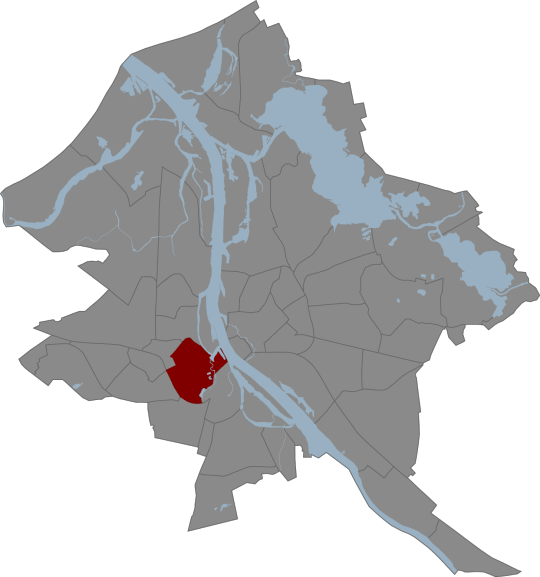
Name: Āgenskalns
Meaning: Translates roughly to “Agens Hill”
Area: 4.61 km2 (27th)
2014 Population: 27,923 (9th)
2008 Population density: 6538 people/km2 (11th)
Distance from Riga Central Station by public transit: 8 minutes (train)
Public transit lines: #3, #4, #4z, #6, #7, #8, #13, #20, #21, #25, #38, #39, #47, #50, #51, #52, and #55 busses; #1, #5, #9, #11, #13, #18, #22, and #23 trolleybusses; #2, #4, #5, and #10 trams
Places of interest: Kalnciema Kvartāls, Uzvaras parks (Victory Park), Āgenskalna tirgus (market), Māras Dīķis, Alises torņis (water tower),
Date of Visit: March 18, 2016
Last month we visited the cultural hub of the Pārdaugava region: Āgenskalns. One of the city’s most well-known and instantly recognizable areas, nearly anyone who has ever crossed the Daugava river to the city’s western half has been through at least a bit of the neighborhood, as two of the city’s four bridges cross into it. From Vecrīga, it’s just a five-minute walk across Akmens tilts (stone bridge).

While the Rīga-Tukums line makes for a logical southwest border and the rivers clearly cut the neighborhood off from the rest of the city, the other borders seem a bit arbitrary and fuzzy. This is even more apparent when looking from above. Many people refer to a much greater area than just that in the red lines as “Āgenskalns,” while others might consider much of that northern area above Kalnciema iela part of of Zasulauks.
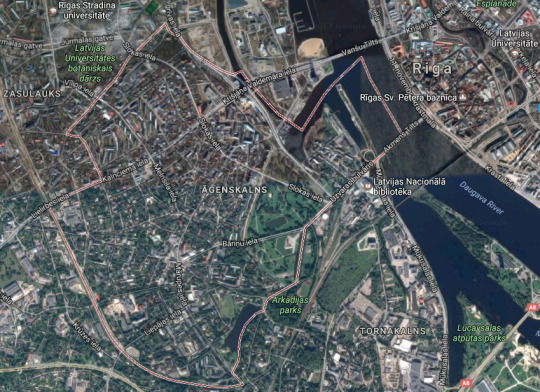
The good news was that we would be exploring Āgenskalns with our friend Konstantin, a life-long resident of Rīga with an encyclopedic knowledge of the history of the city’s buildings thanks to many hours spent researching online and in the city’s archives. Even better, he’s from the neighboring region of Zasulauks just to the northwest, so he was able to provide us with particularly generous wealth of information about Āgenskalns. The bad news was that the only day that him, Līga and I could all go together happened to be the one rainy day in a string of otherwise perfectly sunny and relatively warm days. While Konstantin’s philosophy was that this part of Rīga looks good even in gray and drizzly weather, I feel a bit bad that we weren’t able to do this beautiful neighborhood justice with such dreary backdrop.
Līga was a bit busy earlier in the day, so I met Konstantin by myself first to check out the area by the river before she would join up with us a bit later. I got on a #3 bus from the station and took it just two stops before getting off at the Nacionalā bibliotēka (national library) stop where I met up with Konstantin.

We started on towards the river, walking first by a beautiful pinkish pre-war building that Konstantin told us was used by the Soviet government as a teacher training academy. Apparently during Soviet times teachers were not required to have a university-level education, so it was something more akin to today’s trade schools. To the immediate left was what looked at first like a newly renovated pre-war building until Konstantin told me about the interesting history behind it. Apparently it was a derelict abandoned building before Latvia hosted the EU Council presidency back in early 2015. Since the library across the street was to be used to host dignitaries throughout the six months, the city ordered the owners to give the building a facelift, resulting in a freshly painted skeleton. I couldn’t believe this until we got closer and I was able to see inside for myself.



It’s inconceivable to me that this prime real estate so close to the river and tram lines had not been properly renovated by some savvy developer, but there are many other situations just like this throughout the city. Across the street was a somewhat unusually decorative Hruščovka with an interesting brick pattern. I might not have mentioned it previously, but one interesting thing about at least the brick version of these Soviet projects is that the year is usually inscribed at the top using differently colored bricks.

Continuing down the road, we came to an abandoned old police station across the street from a 90s-era housing construction. As is the problem with nearly any city in the world, it was sad to see such a beautiful structure fall into a state of disrepair which at this point would probably prevent it from being reconstructed in an economically efficient way. Its juxtaposition across from those modern condos were a bit poignant in illustrating how preservation can be lost as an urban priority.



Just a bit further on, we crossed onto the AB Dambis, a large jetty first constructed from wood in the 1880s to regulate the Daugava's flow and for loading and unloading boats. The structure was destroyed by the German army during WWII before being reconstructed in its current form by the Soviet army. If you're interested in learning more about it's history, you can check out this post from Cita Rīga (in Latvian, but can be translated). We walked out to the furthest point and took a few pictures of Vecrīga's skyline and of where we would soon be walking in Āgenskalns.




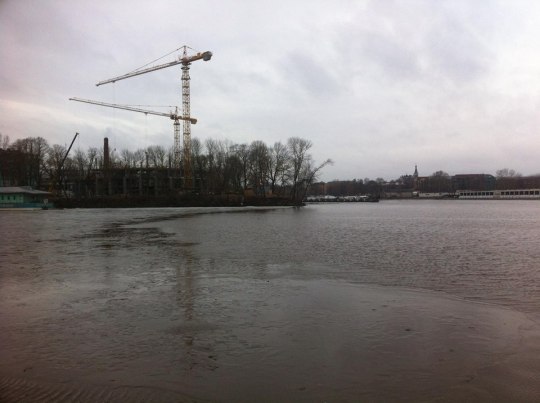
I got a call from Līga who said that she would meet us soon at the same libary bus stop where I had met Konstantin, so we started heading back in that direction. After waiting about ten minutes at the bus stop, we finally met up with Līga and started down the gray brick road of Valguna iela. To get there we passed under a concrete residential building which like a few others in the neighborhood had been constructed over the road itself. According to Konstantin, this was an “experimental” residential project which was not replicated due to its uncomfortably cramped living conditions and non-intuitive navigation on the inside. Along this road were a row of Stalin-era buildings on the left and some older wooden ones on the right.

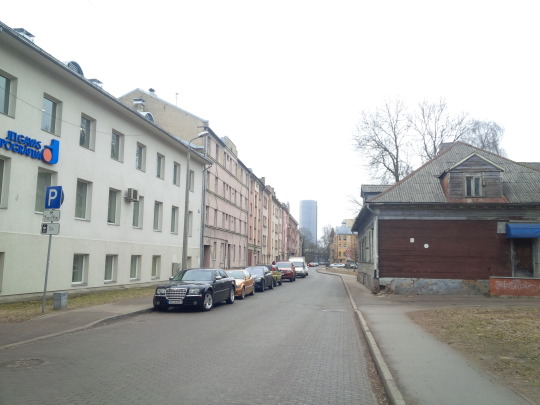
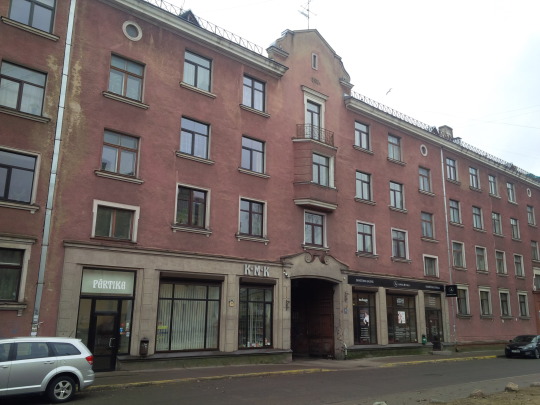
To our right there was a building which Konstantin pointed out was built on top of what had previously been part of Staraja Rusas iela, one of the only remaining streets in the city with a Russian name. While it's no longer officially part of that road (at least according to Google maps), it was interesting to see that some history-conscious person had written the name of the street above the driveway to preserve its memory. We also passed a what seemed to be somewhat nightmarish pre-school/kindergarten, along with a fairly scary balcony.
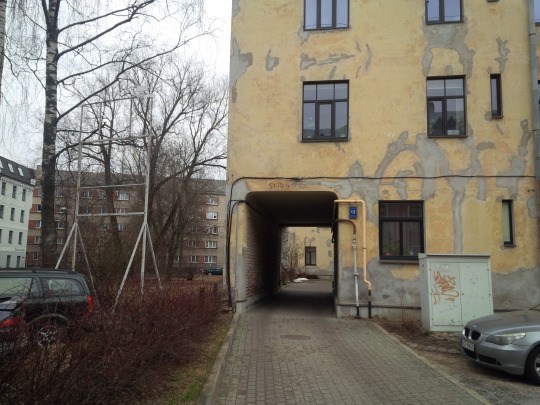


We came to the end of Valgumu iela, and before turning right onto Trijādības iela, we saw what Konstantin said had been a riverboat repair facility before being abandoned. We walked down Trijādības iela towards the river, seeing on our right a typical back yard with trees benches that are very commonly seen next to buildings built in the first half of the 20th century all the way up until the end of Stalin's time. A graffiti ghost on the wall seemed worried or upset about something; maybe we had gotten too close...



Unforunately we couldn't get any closer to the river since the construction area we had seen from AB Dambis was gated off, but Konstantin pointed out one very interesting building before we left. I wouldn't have noticed it on my own, but the two-story house was built in the traditional Latvian style that can be seen throughout the countryside, with the roof slanting on all four sides. Generally these houses are made of wood, so it was a bit unusual to see one here made of brick, further adding to my impression of Āgenskalns as one large architectural gallery. We passed by Latvia's sea administration and a modern apartment complex before coming again to the abandoned riverboat factory as well as a row of very typical brick hruščovkas and another scary-looking kindergarten.
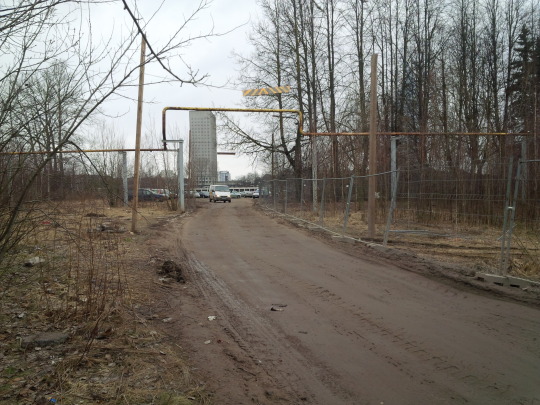




We took a right onto Raņķa dambis, which quickly turned into Daugavgrīvas iela. Although winter was more or less over, the cove of Zunds canal still had a thin layer of ice covering it. We got a good view of the old riverboat repair factory with some Latvian graffiti on the side and then saw some modern riverboats being repaired right in front of our eyes. Since there is no longer a dedicated facility, a man was standing on top doing some welding right in the open on the deck. We also passed my favorite place in Rīga to drink outisde during warm weather months, Piķis un Zēģele, a relatively cheap pub with a deck overlooking the water. If you're ever here in the summer months and love to sit back and relax outside with good, reasonably priced beer while watching boats go by, definitely check it out.




Just across Daugavgrīvas iela from the road to Ķīpsala, Konstantin pointed out a beautiful pre-war building which used to be a polyclinic for children and teens which unfortunately was now in such a state of disrepair that it had no floors. To the right was another beautiful pre-war building which was derelict aside from the first floor, this one having a commemorative plaque for Latvian composer Pēteris Barisons who had lived in the house before WWII. A brick hruščovka next door ws in much better condition, and had a variety of stores on the first floor including what looked like a tasty vegetarian restaurant.


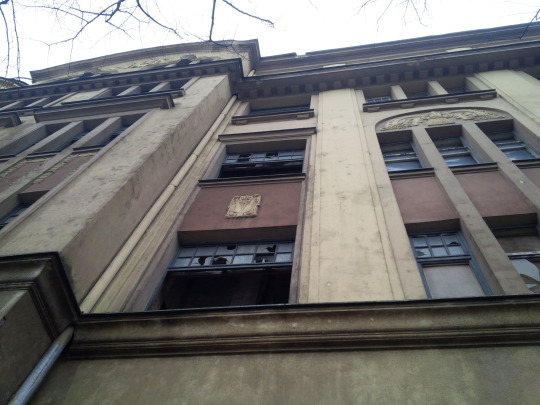


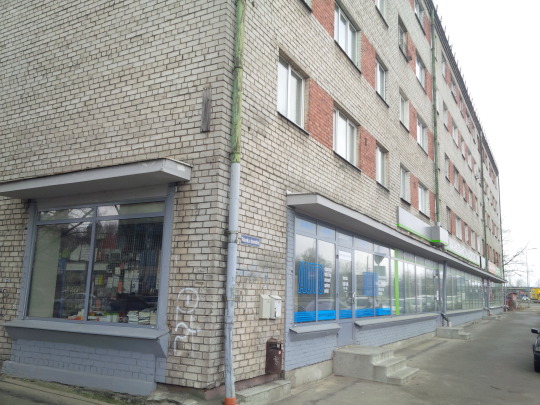

And now we were finally at the base of the infamous “Z-Towers” which had been visible from many previous neighborhoods. As I mentioned briefly in the article about Dzierciems, these troublesome twins had been under construction since 2006 and were conceived in a different era of urban planning just before the 2008 crisis where this area around Ķīpsala was planned to be a sort of financial district for the city and many other similar large buildings had been planned. As it is, it's almost a small miracle that these ones got finished at all. The buildings began sinking not long after construction since engineers had failed to compensate for the marshy ground beneath, and had to halt progress and improvise a new technique for drying out the foundation. The death of a construction worker whose harness tragically failed stopped progress for even longer, and the buildings went through multiple exterior and interior design revisions as it was being constructed to help make it more more economically feasible. As a result, the final minimalist and utterly generic result is a far-cry from the original gaudy and bombastic structure that was originally planned.
First planned to be an upscale hotel in one tower and offices in the other, now the majority of units in both towers have been marketed as luxury apartments of various sizes. Until 2014, it was possible to receive a five-year Latvian residence permit with full access to the EU and a path to citizenship for a property investment of as little as 70,000 Euros. Although parliament bumped that up to 250,000 Euro due to concerns about Latvia's property market being exploited as a massive money-laundering mechanism by international criminals, I'm sure that foreigners with an interest in accessing the European common market should have no problem finding a unit worth a quarter of a million in these glass behemoths. On one hand these towers further justify Āgenskalns' reputation as an architectural mecca, but at the same time even for this neighborhood they stick out like Siskel and Ebert's thumbs banged with a hammer by a bitter director. While it's easy to dismiss them as yet another tacky monument to the anonymous global 1%, I like to think of them as a relic from a more optimistic time in the city's history when the sky seemed the literal limit for ambitious developers just before it fell in spectacular fashion just a short time later. For more information about the history and future of this ongoing saga, check out this incredible thread on skyscrapercity.com which has been documenting the building's progress over the past ten years.
When we tried to get up close to the buildings, a security guard at the gate predictably banged on the glass and yelled at us to get lost. We were still able to get a nice look at the impressive structures as we hung left onto Krišjāņa Valdemāra iela and started up the hill towards the northern part of the neighborhood.



While the same can be observed in pretty much all of the city's more central neighborhoods, the clash between “old” and “new” is especially striking here. Aside from the obvious example of Z-Towers, this street was lined by a mix of small pre-war wooden houses, concrete and plaster early 20th century buildings, and glass and steel constructions which look like they had been dropped off by a visiting UFO.



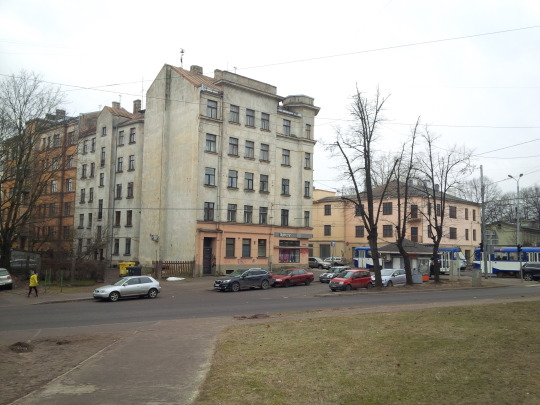

So far, this had been our route since we had met Līga near the library:

We now started down the major thoroughfare of Slokas iela, coming up close to one of Konstantin's and my favorite looking buildings in the city: the national historical archives. I'll let the pictures speak for themselves in terms of how awesome this building looks. The archives are free to browse, but professional photocopies to be brought home cost a fee. Luckily, scores of benevolent history fans have uploaded a lot of material contained there for free to various forums and websites. Much of the information contained there is in Russian due to that being the lingua franca and official language of the Soviet Union, so proficiency is required for serious browsing/research. Documents from 1920-40 though are mostly all in Latvian.
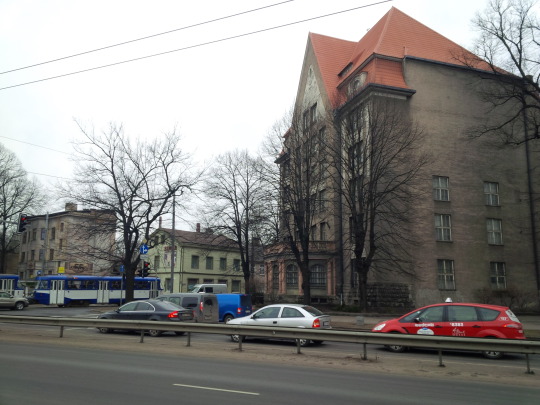


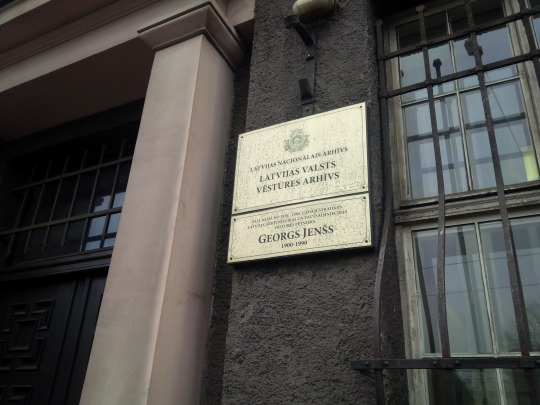

Slokas iela contained a nice mix of older wooden houses and Rīga's famous art nouveau buildings from the early 20th century. On one of the buildings, we found a subtle but interesting historical relic. During Soviet times, all of the street names were written in both Latvian and Russian throughout the city. After regaining independence, the government began replacing them with newer, Latvian-only plaques. On this particular building instead of replacing the entire sign, someone simply painted over the Russian version of the signage which had been found on the bottom of the sign. The result was surprisingly effective, as I never would have noticed if Konstantin hadn't pointed it out to me. We walked left down Mārtiņa iela and then left down the offshoot of Daugavgrīvas iela. No matter how far we walked away from them, Z-Towers loomed behind us.

Jugenstils (art nouveau)
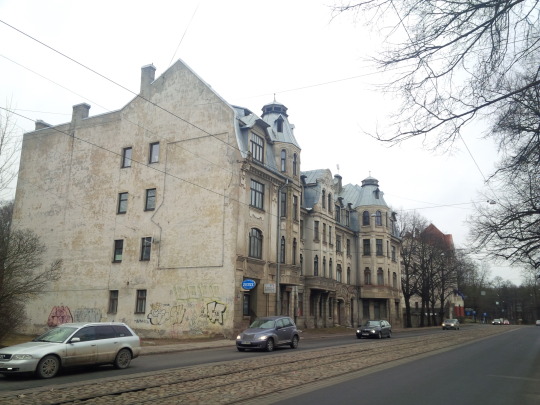




And now we came up to one of my many weird civil planning-related obsessions: a ghost ramp! These “roads to nowhere” are offshoots of other roads that are built to connect with a future transportation project that for one reason or another never quite materializes. This particular one was intended to connect with one of the many aforementioned projects intended for the Ķīpsala area before the bubble burst in 2008. If Z-Towers are a semi-living monument to the pre-crash era of naive optimism and big thinking, then this ramp is something like a poignant and symbolic memorial. I was excited to finally have an excuse to go onto this ramp that I had passed so many times before on my way to work, and from it we had a nice view of the tall buildings as well as the former territory of a factory that built farm machinery just underneath where the ramp is now. We also got a view of the northern edge of Āgenskalns where we were headed next.
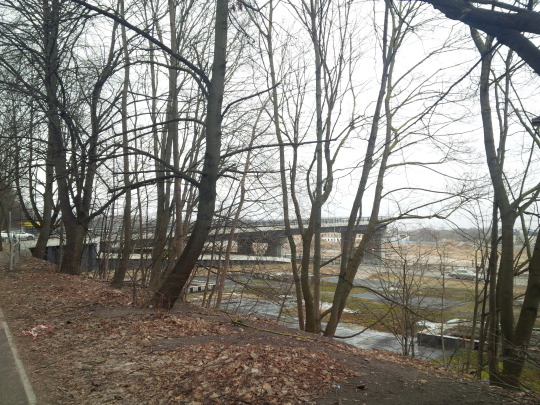

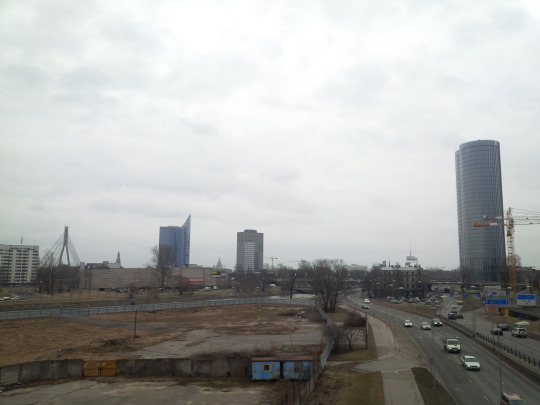

We walked towards Mārtiņa Evaņģēliski luteriskā baznīca (St. Martin's Church), passing two older art nouveau buildings: a current police station to the left, and an apartment complex with a classical-style sculpture out front to the right. When we got to the church's back yard, we took the path through crossing back to Slokas iela. The Romanesque church was built in 1851 and 1852, and the red twin steeples are visible from most of the northern part of the neighborhood. Konstantin pointed out the odd fact that the lantern is built in such a way that it can be lowered using a pulley.
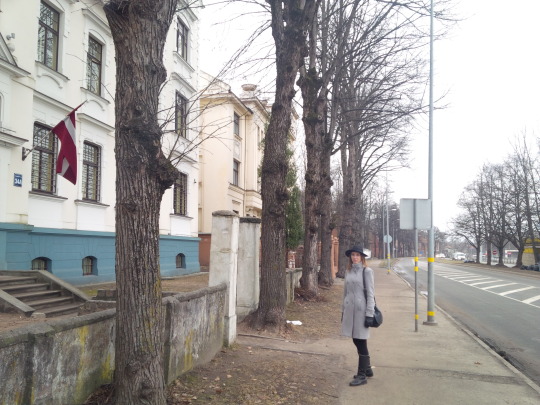
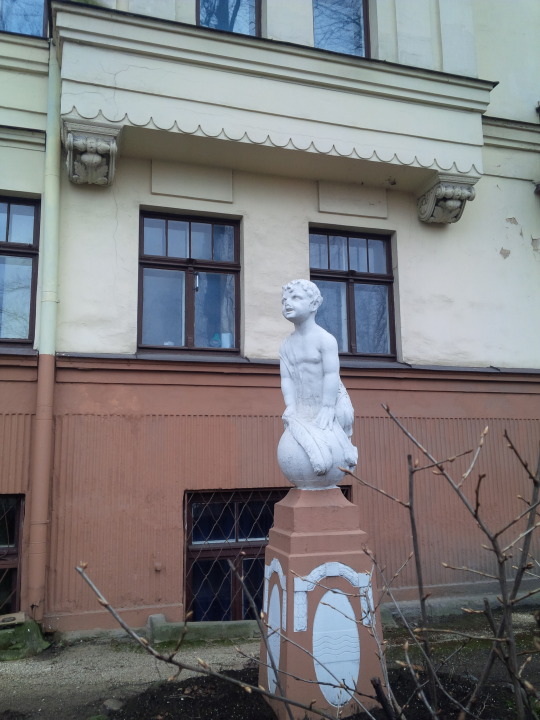

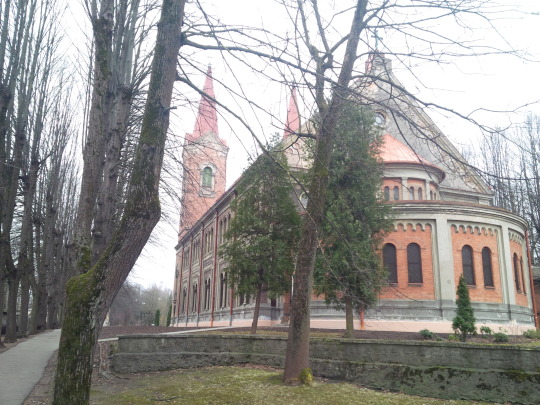

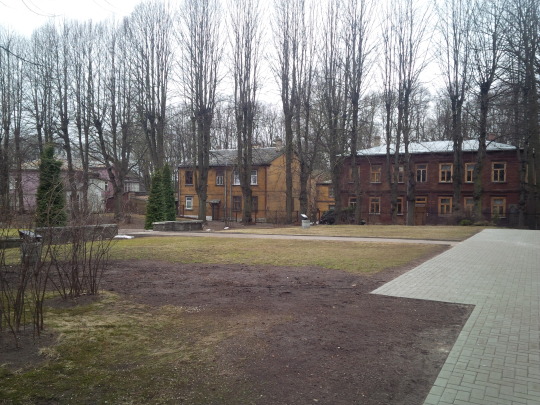
lowerable lamp

Coming out of the church yard and turning left onto Slokas iela, we passed a cool purple wooden building and a music school before coming to the nearly-abandoned Mārtiņa kapi (St. Martin's Cemetery). Many of those resting in this graveyard have no living relatives to maintain their graves, although we could see a few modern tombstones that distant descendants had bought for their long-departed ancestors. Following the tram line down the street we also passed the very modern purple courthouse before we turned right down Kuldīgas iela.
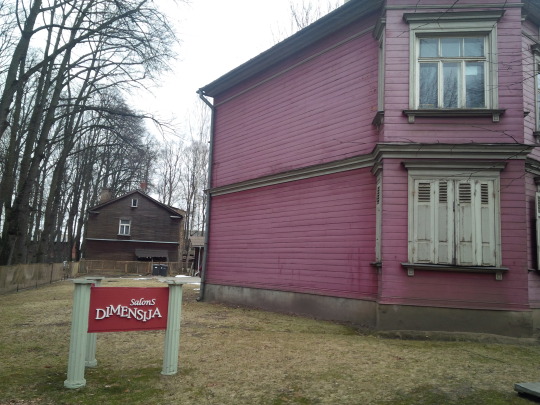

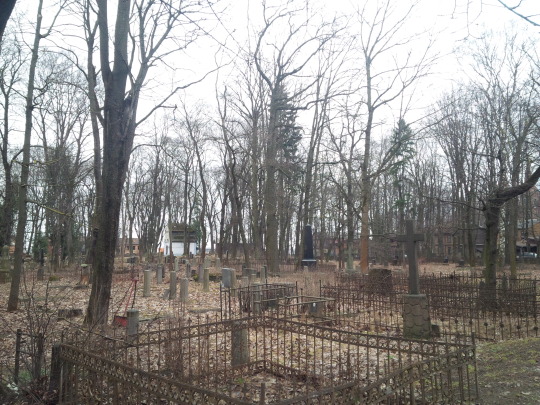



Just as we were turning left down Kuldīgas iela, we saw a plot of land adjacent to the botanical garden that seemed like it was part of the garden's territory until Konstantin explained that it was actually a private plot in the process of being sold. That explained why it had the old-fashioned wooden fence while the rest of the garden had a much newer metal one surrounding it. Signs of spring were everywhere as we continued down the street; people were raking up leftover leaves now that the snow had almost all melted, and small flowers were starting to bloom here and there. When we came to busy Vilpa iela, we turned left and came to Rīgas Valsts vācu ģimnāzija (State German Gymnasium), one of the city's oldest high schools founded in 1921. During months when leaves are on the trees, the school is hidden from the road except for the wooden “window” which you can see in the first picture of the school. Unfortunately, at this time of year the effect gets lost.

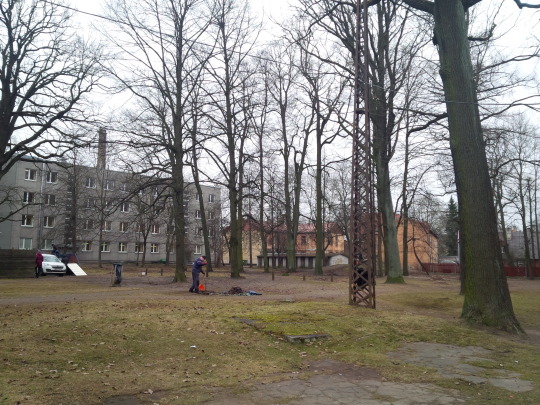

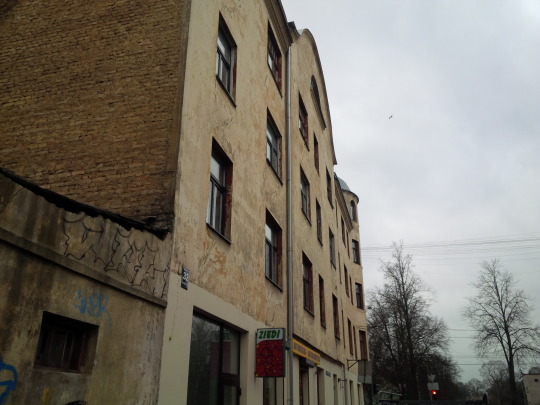
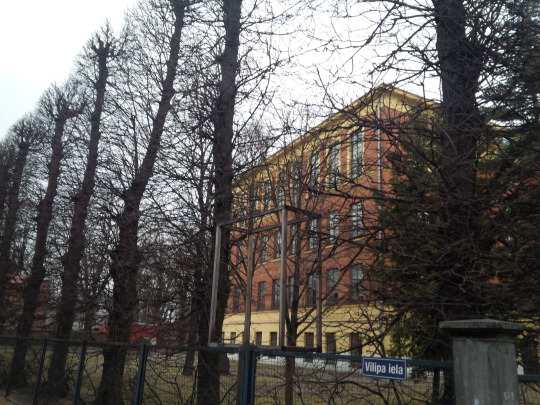
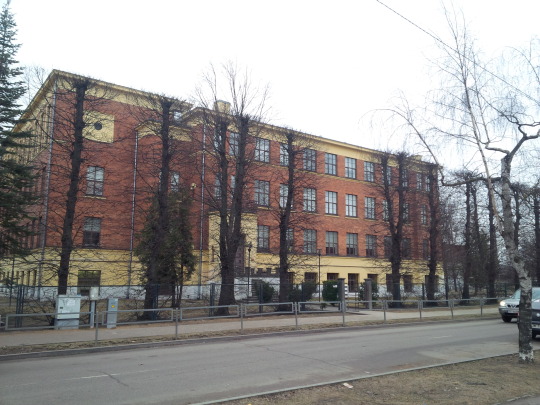
At the corner of Melnsila and Āgenskalna ielas, we found what Konstantin explained was called “Āgenskalna Priedes” (Agenskalns Pines). This early and experimental “micro-district” that the Soviets constructed in the late 1950s was the first of many often much larger projects in the further-out neighborhoods of the city which were constructed all the way through the 1980s. These concrete-panel buildings are some of the first very early hruščovkas to be built in the city in response to the post-war housing crisis that was only exacerbated by Stalin's obsession with ornate, decorative buildings which took too long to construct to meet the population's needs. Konstantin told us that while these buildings look to be in good condition from the outside, many have problems with electrical wiring beneath the floors that were not properly installed during the original construction.
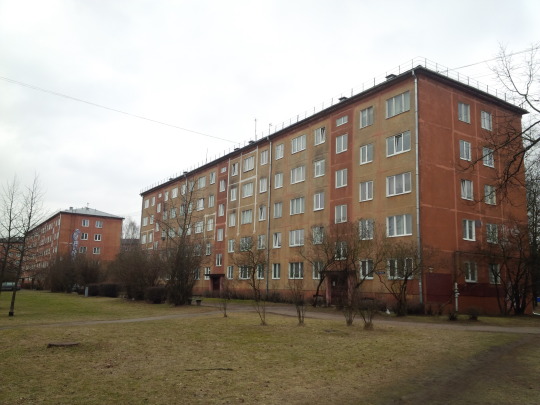



This housing project also has one of the last Soviet-era playgrounds to not be torn down to to safety concerns. The metal playground equipment you can see used to be ubiquitous throughout the city's suburban districts, but since independence the city has mostly favored removal over renovation. The building you can see in the background looks new, but is actually a recent renovation of a pre-war building. Seeing the potential of what could be if more of the city's gorgeous old structures received the same love and attention only makes it sadder to think about many of the other buildings' current states.
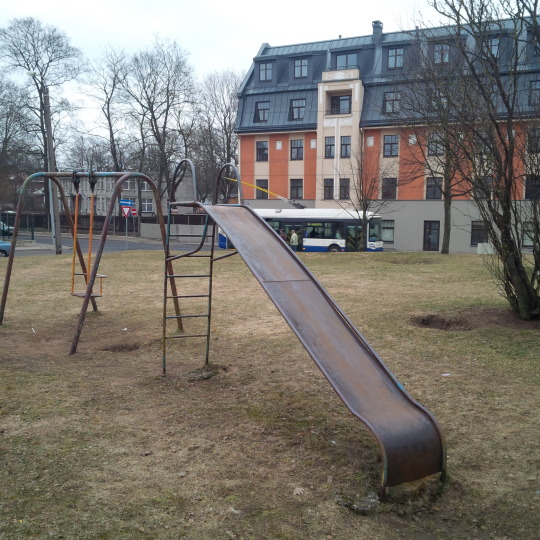
From the background of the development we could finally get a great view of one of the neighborhood's most famous landmarks: the water tower named “Alise” Yes, believe it or not, some of the city's gorgeous water towers have these kinds of names. After this particular one stopped being used for its original purpose due to introduction of more modern distribution methods, the building was used as an underground record label/studio until the late-2000s. The owner of the Coffee Tower chain and a few other bidders tried to buy it, but the city deemed it a historical monument before it could fall into private ownership. Hopeful the city will maintain and find a good municipal use for this beautiful landmark, as the building really is a stunning piece of architecture.
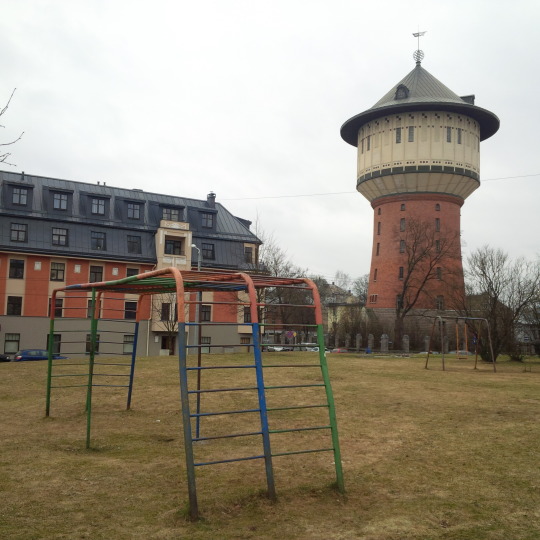

We turned back onto Melnsila iela and passed a wooden building with a store called “Alus pagrabiņš” (which translates to something like “Little Beer Basement”), a store which sells unusual and hard-to-find beers both on tap and in bottles. People often buy large plastic bottles of the beer straight from the tap so that they can bring it home and drink later, which is usually cheeper than buying glass bottles or cans.
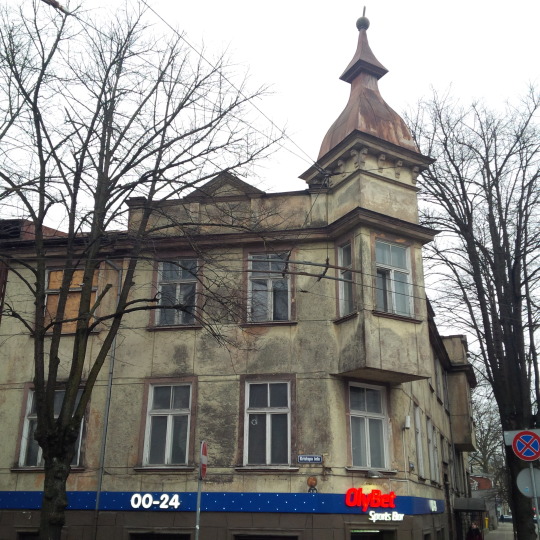

Now we came to the famous “Kalnviema kvartāls” (Kalnciema Quarter), a group of wooden buildings on the corner of Mensila and Kalnciema ielas. One of the most well-known enclaves of the city's “creative class,” the mini-district features various shops, galleries, offices, and performances spaces, and hosts many cultural events including a weekly Saturday market in the main yard between the buildings. We regretted not being able to come here a day later to check out the market, but I would strongly encourage visiting it if you can make it out here on a Saturday. For any of you who are fans of good wine, there's also a fantastic wine shop and cafe open every day except Sunday from 10-22.

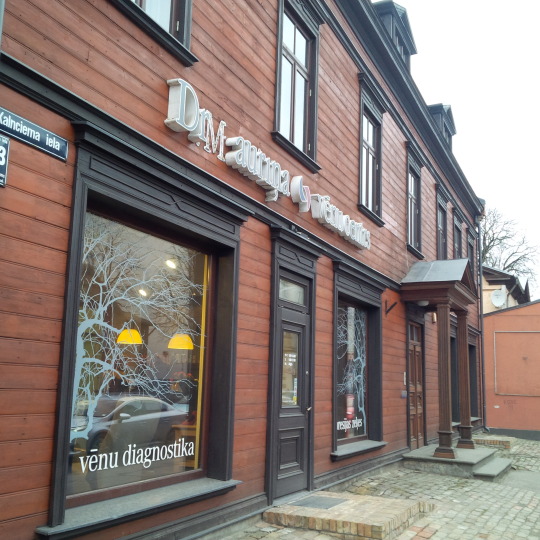

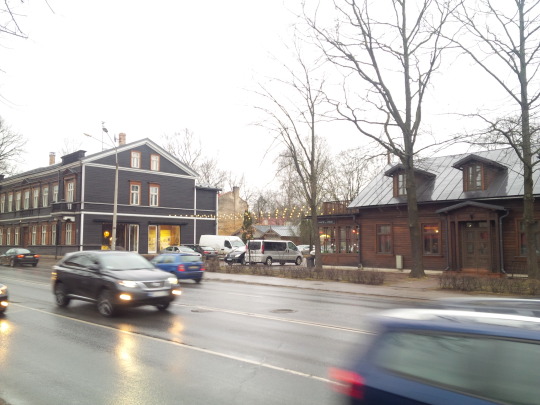
We were pretty hungry at this point, so Konstantin suggested that we try a kebab place called “Fix Box” which he had passed many times before but never actually tried. The interior was modern and colorful, and the prices seemed fairly reasonable so we decided to give it a shot. The wrap was toasted and crispy, which was a bit unusual for Riga's kebab places as they usually wrap them in softer shells. Overall the kebabs were pretty good, but I'm not sure it was mind-blowing enough to recommend coming all the way from the center for considering the wealth of options there to try. If you're in the area and love kebabs though, I doubt you'll be disappointed.
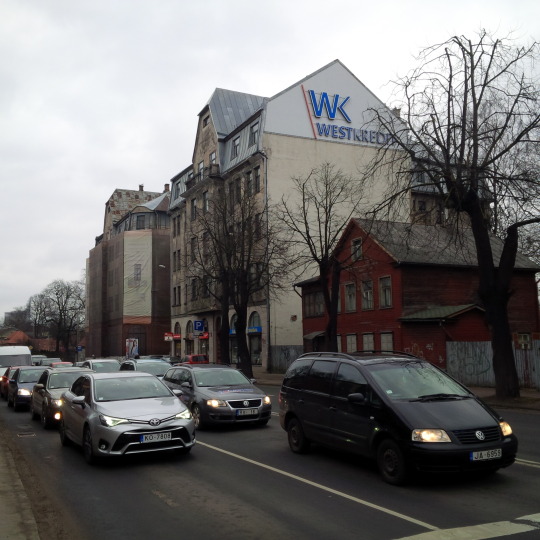

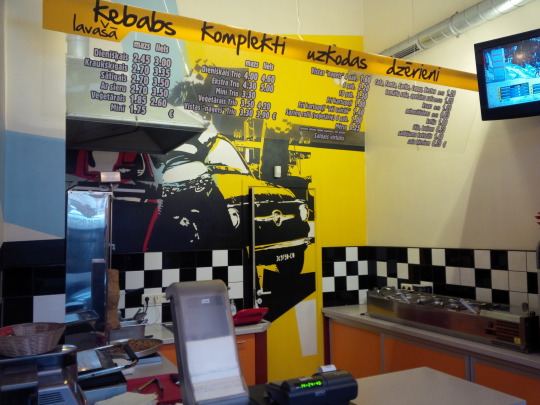

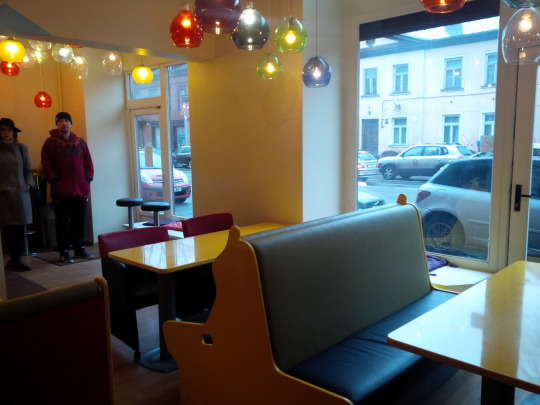

Since the ghost ramp, here is more or less the path that we had taken to the kebab spot:

As we left our lunch place, the weather began to take a turn for the worse that would gradually only worsen. Undeterred, we continued southwest down Kalnciema iela before hanging right onto Sabiles iela. Down this street the mishmash of modern and older architectural styles continued, although in this part of Āgenskalns most all of the buildings didn't reach more than three stories tall. Konstantin pointed out that the dilapidated green building at the end of the road had been “somewhat renovated” on the very right side, which is not uncommon for some of Riga's older buildings in such condition considering that many such buildings have multiple owners. A lot of the older wooden houses throughout the city are split into halves or even quarters depending on the size, and this can be reflected sometimes in the buildings' visual appearance.

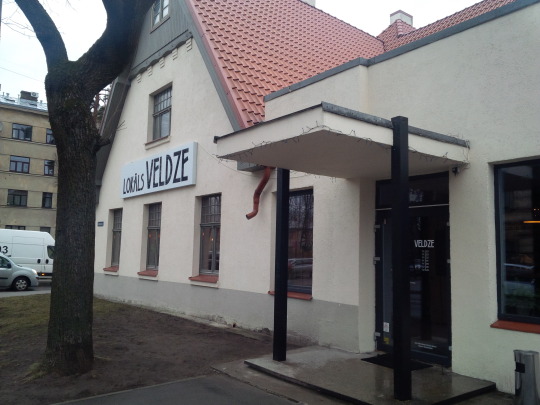


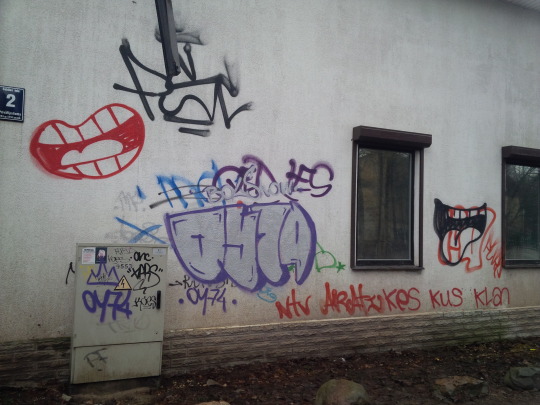

At this point, Sabiles iela turned into Talsu iela, and we continued on towards the more urban part of Āgenskalns. Right at the start of Talsu iela I saw one of the coolest yet strangest-looking houses I've ever seen, which seemed as if the architect was torn between three different styles and chose all three. A bit further down the road, we got a glimpse at the old TV tower. Before moving to is current headquarters on Lucavsala in the middle of the Daugava, Latvia's Television used to be headquartered in Āgenskalns, and used this tower to broadcast. According to Konstantin, the city has deemed the tower as a “dangerous object” and has ordered it to be repaired immediately. Regardless of its perilous state of repair, the tower still currently broadcasts Radio Merkurs on 1485 kHz (AM).


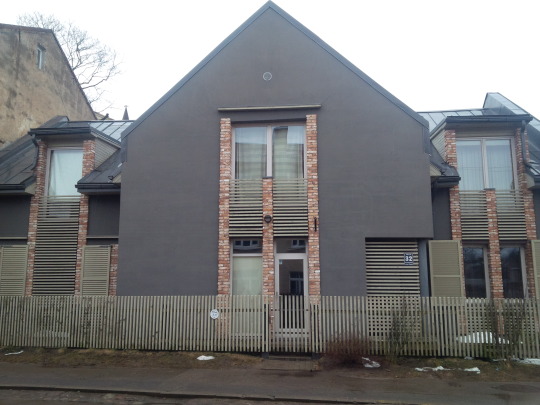


We turned now left onto Nometņu iela since Konstantin wanted to show us a few different buildings this way. We found a sad wall that was either bemoaning street litter or had very low self esteem. A bit further down we came to the first of the buildings that Konstantin had mentioned, a “communebar” called “Hāgenskalna Komūna.” He told us that it's the best place this side of the river to hear small acoustic concerts, although various DJs also play sets. Apparently they also offer a good selection of food and drinks, so we plan to check it out sometime soon.
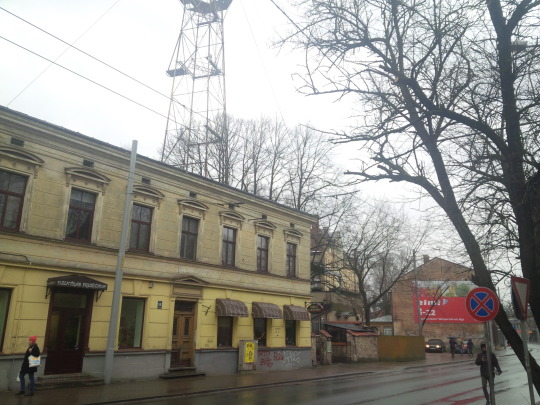


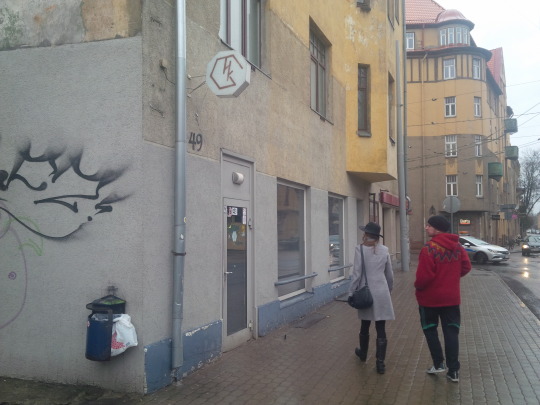

Just past the corner of Lapu and Nomeņtu ielas we came across the scariest-looking balconies on the planet, which were all missing floors. They were (barely) attached to one of the coolest-looking buildings in the entire neighborhood, a strange castle-shaped one over which there is a dispute as to which architect designed it. Apparently two people claimed to have drawn the original design. Next we found what is a very popular trend in America but something I had so far yet to have seen in Latvia: former cinemas converted into evangelical churches. The first was a brown Art Deco-ish one on the left which now hosts the “Dzīvā Ūdens Avots” (living water source) Pentecostal Church, and the second was a tan-colored one just down the street which is inhabited by the “Jēzus ir Kungs” (Jesus is Lord) evangelical church. The second was offering an “alpha course,” a basic introduction to Christianity that was popularized in the UK but can now be found all over the world.









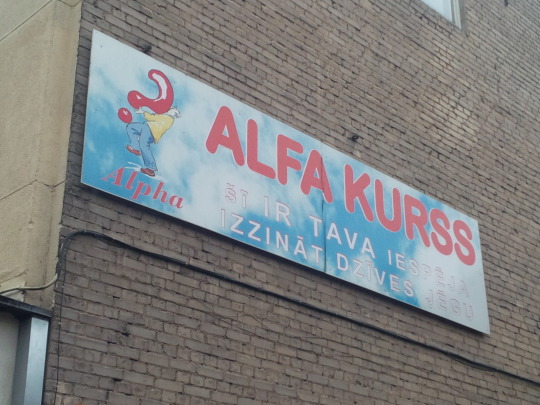
Continuing down the street, we saw more wooden and brick buildings from various eras. Shops included a fancy-sounding “brick salon” (yes, a salon in which you buy bricks), a door and window ship, a pizza place, an upscale restaurant, an antique shop, and another location of one of Līga and my favorite cafes in the city: Ciemakuklis, which we visited in Dzirciems last year. At the intersection with Slokas iela we took a left.
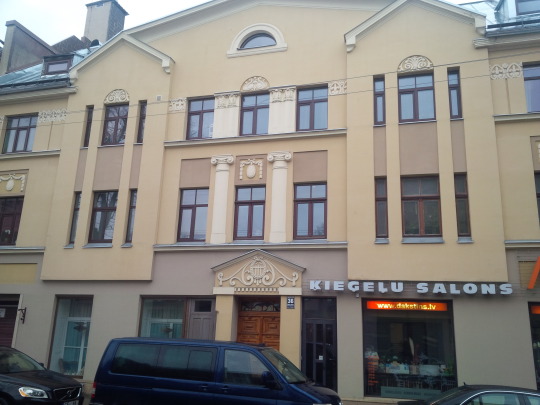


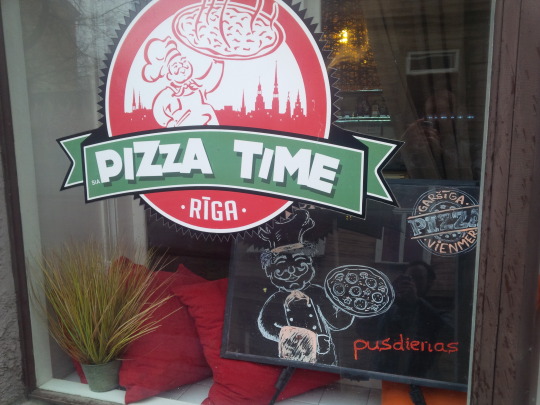


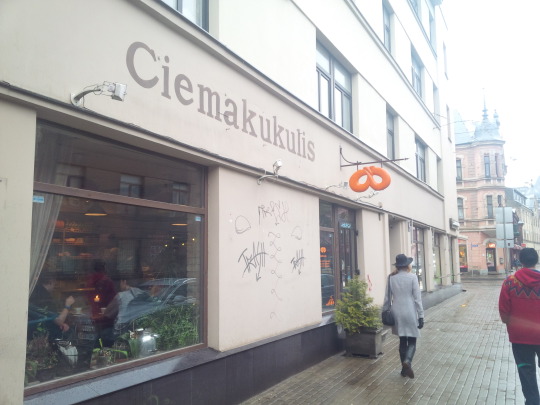

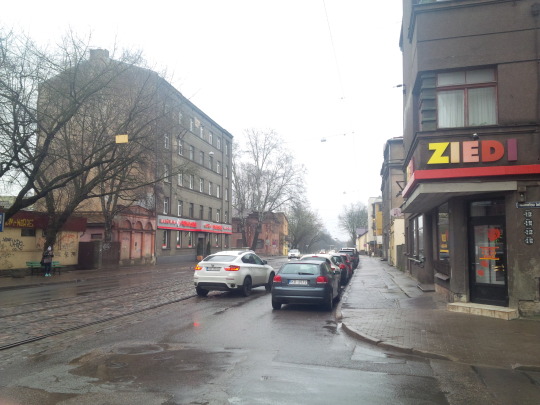
On Slokas iela, Z-Towers once again reappeared and loomed in the distance. We walked first by a church called Latvijas apvienotā metodistu baznīca (Latvian United Methodist Church), one of the few methodist churches in the country. Next door was an old white building which Konstantin said used to be used as a wedding registry. He told us that his parents had registered their marriage there, and that they were sad to see it become derelict throughout the years. We were just about at the corner of Slokas and Kalnciema iela again where the state archive was, so we took a few pictures and then hung left down Ernestīnes iela back towards the market square.

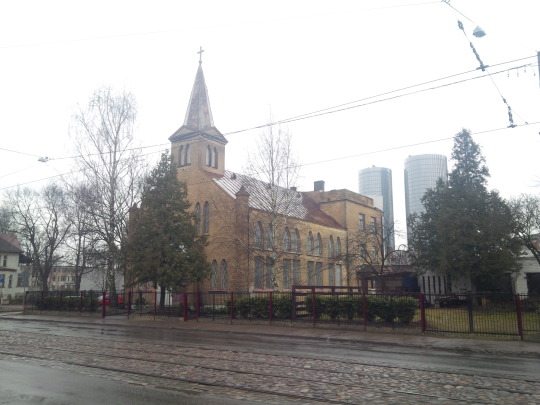



Ernistines iela cut through yet another district of short, wooden houses, but this part of town contained some of the city's most well-known schools. The first was Rīgas Dabaszinību skola (Riga School of Natural Science), a UNESCO-affiliated youth education center that puts on various workshops and activities related to natural science. The gate looked open and we wanted to take a look through the school's grounds, but we opted against it. Across the street was the well-regarded Āgenskalna Valsts ģimnāzija (Agenskalns State Gymnasium), a high school that is consistently ranked in the country's top five in terms of exam results and student achievement. The third we passed was the newly renovated Rīgas 53. vidusskola right on the corner of Ernestine and Melnsila ielas.





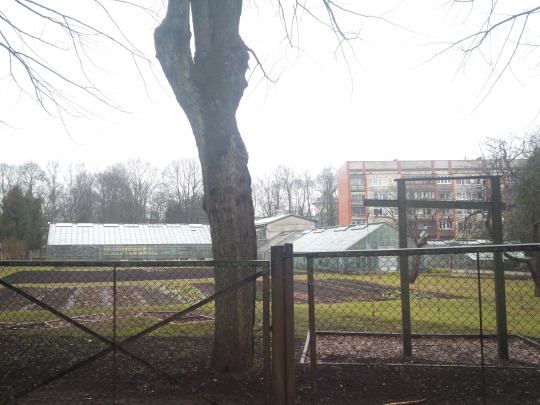



As we turned left back onto the larger road, we saw a car driving by with some large metal piping tied dubiously onto the roof. This reminded me of how in my home state of Maine it’s not uncommon to see pickup trucks on the highway with large stacks of various items tied precariously onto the bed, and how its occasionally necessary to dodge them when they fall out onto the road in front of you. We followed Melnsila diela back down to Nometņu iela where we took a right and started heading toward the market.
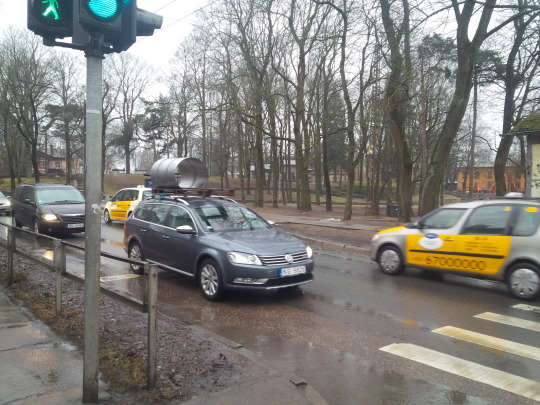
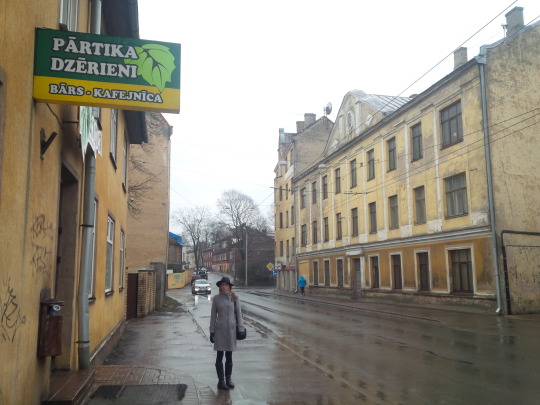
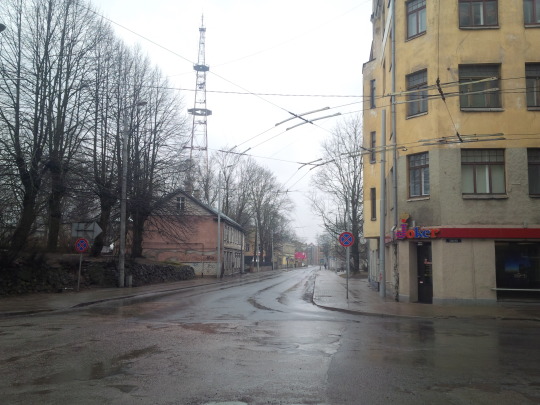
Since leaving the kebab spot, we had walked in this very strange spiral-shaped path:

On our way to the market we passed by one of the city's rare food trucks as well as two cafes situated next to the old tower. It's a bit hard to see from the picture, but one of the tower's supporting guy wires had been decorated with colorful ropes. Konstantin told us that the SEB building (one of Latvia's most popular banks) used to be taller, but that the top floor had been removed during renovation to help make the building more sturdy.
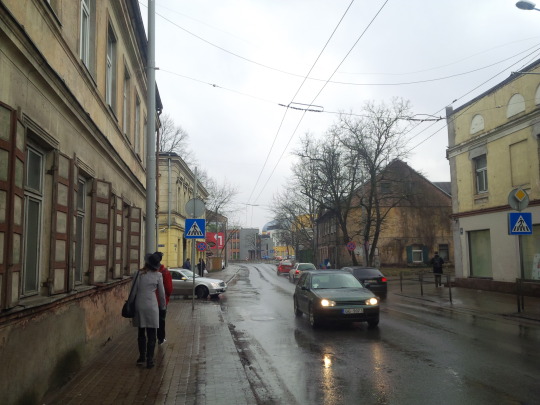


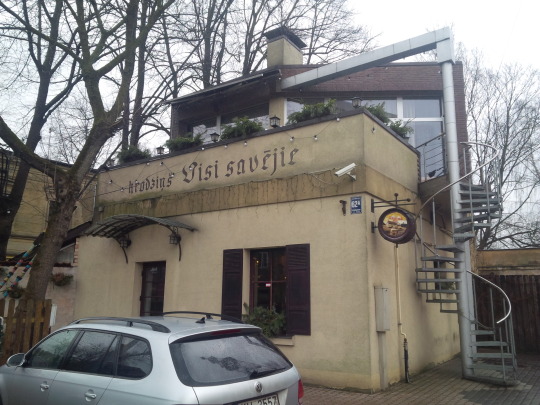

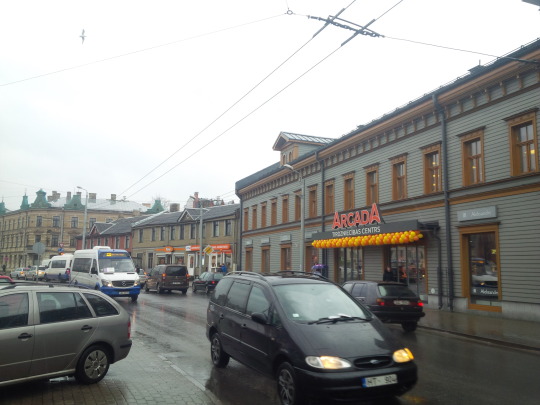
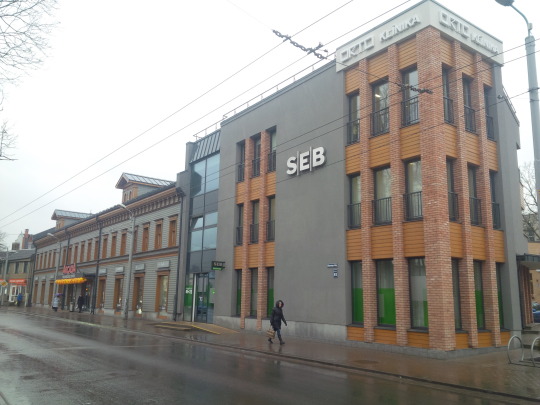
In the market square there were a bunch of posters for a theater event called “Obama Bananas Go,” which according to one of my friends was some sort of abstract high-concept comedy show that had nothing whatsoever to do with former President Obama. While I was shocked at first and am sure that the poster would have not only been taken down within hours but also sparked outrage if it were posted in the United States, Latvia has so few people of color that conversations about race are nearly non-existent and some of my students even have a hard time understanding why they can't use the n-word even though they hear it often in rap music. That doesn't stop me from trying to educate my students about these issues as much as possible and doing my small part in improving this situation, but I'm not as shocked by this sort of thing as much as I was when I first came here.
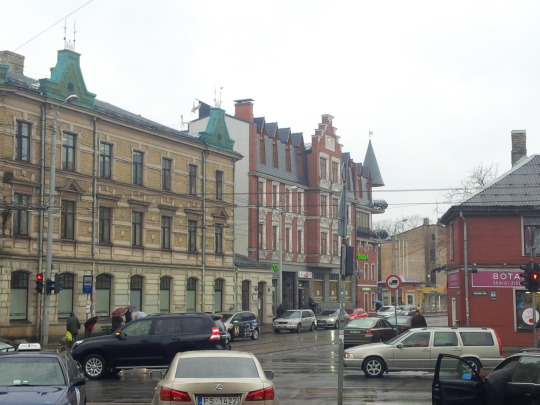
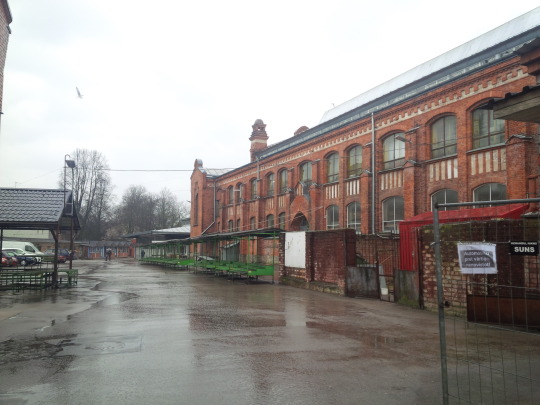
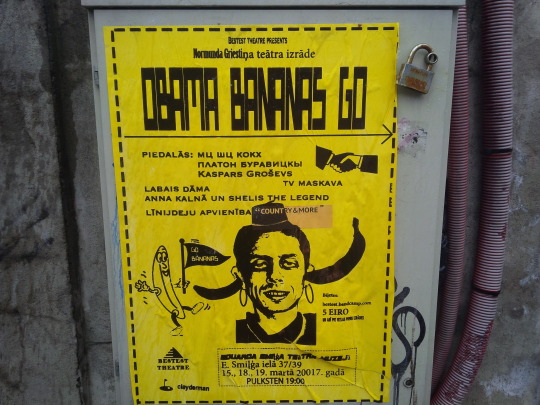
This “trash” frowny face was even sadder than the last one.

The interior of the market building was fairly typical for this region of Europe, but Konstantin told me that he much preferred this one to the more famous and impressive central market in Rīga's center due to its more intimate feel. The walls above the market stands were adorned with the coats of arms of Latvia's cities and towns, which was a nice touch. Luckily the upstairs balcony was open and we were able to get a nice view of the whole inside. There were some very nice looking meats, fruits, and vegetables, but we still had a lot to see and decided that carrying around perishables probably was not the best idea.


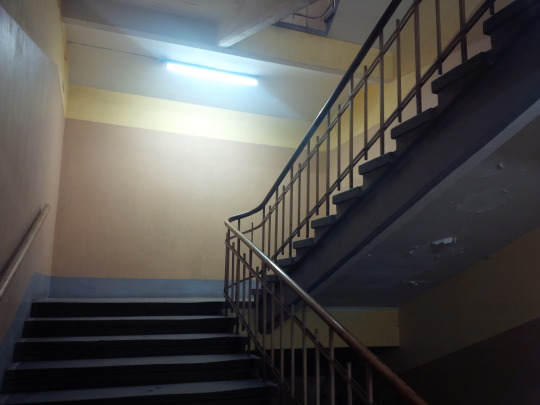

The stands and benches outside were emptier than usual due to the weather, but there were still a few people selling fresh flowers to passers-by. We continued a tiny bit further down Bāriņu iela to one location I had passed by many times but had never been able to get a closer look at: the Eduarda Smiļģa Teātra muzejs, the city's museum of theater. This former home of famed actor and director Eduards Smiļģis (1886-1966) is now run by the Latvian Academy of Culture as a space for exhibitions and live shows. The grounds of the building were gorgeous, but unfortunately we decided that we would have to save the museum itself for another day considering how wet we now were and how little time we had left to see the rest of the neighborhood.


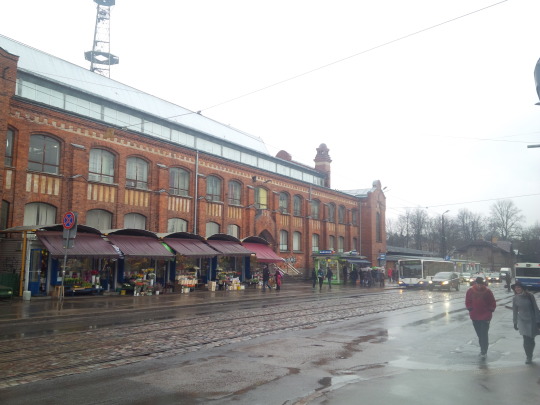
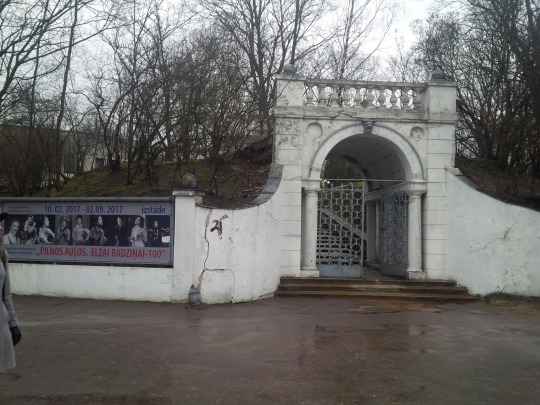




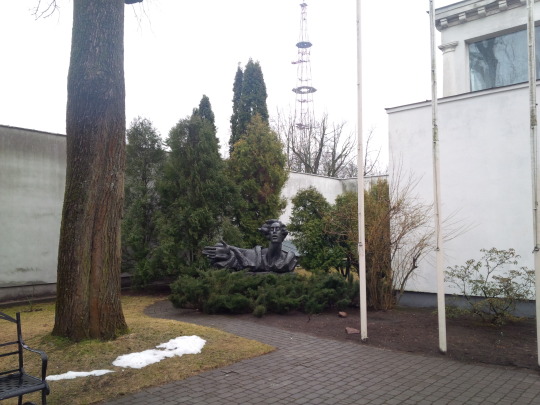
Līga wanted to see Svētā Alberta (St. Albert's), one of her favorite churches, so we headed towards it via a roundabout route past Māras diķis (Mara's pond). We started past the beautifully painted Rīgas Friča Brīvzemnieka pamatskola, one of the city's most historic elementary schools. The far less attractive concrete box across the street was Rīgas Pārdaugavas izpilddirekcija, home to a variety of government services available to those living on this side of the river. This style of building which looks brutalist to American or British eyes is incredibly common throughout the former Soviet Union for various municipal or education-related institutions. As we got closer to the park, we passed a few more wooden and brick buildings built before WWII as well as a few very modern constructions.

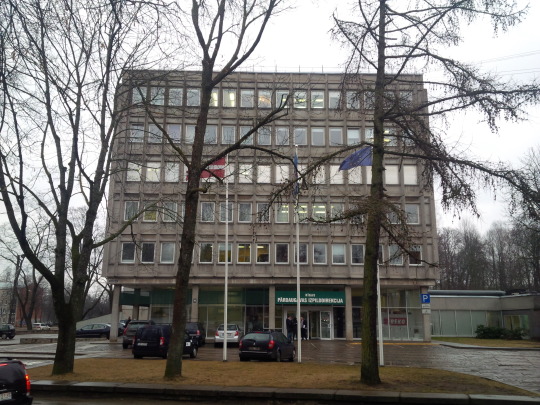


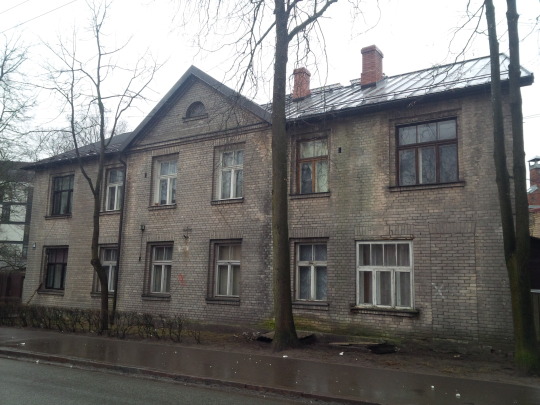



Right near the pond there was a small park with a hill formed from a split between Kokles iela and Mazā Nometņu iela. There wasn't any information that we could find about it, but it seemed like a natural extension of Arkādijas parks in Torņakalns on the other side of the road. The park seemed pretty well-maintained, and at the top of the hill there was a decent view of the surrounding area including the pond.





As you can see from the last picture, Māras diķis is lined on its eastern coast by a walled-off mansions. Thankfully, the entire circumference of the pond is accessible via a paved walking trail. The pond was used for mills all the way back to the 13th century, although the most recent mill was torn down in the 1920s. These days it's only used for recreational purposes, but no swimming is allowed.

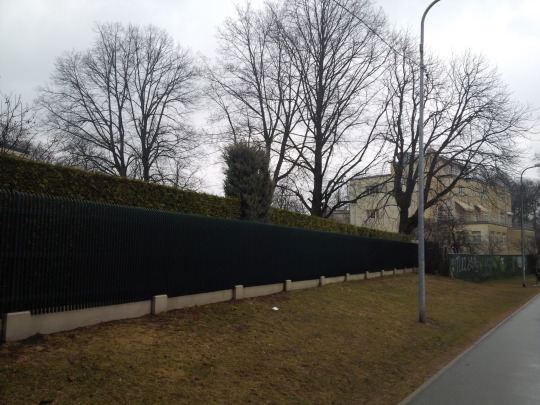
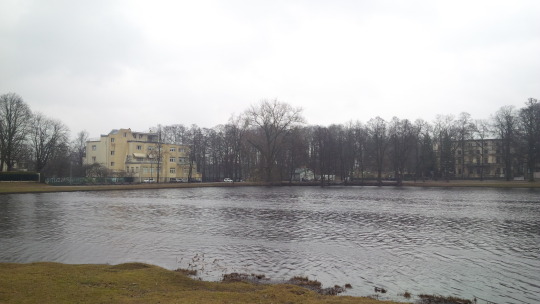




Having walked around the pond, we headed straight down Mārupes iela where there was a mix of residential buildings and student housing for Rīgas Stradiņa universitāte, the country’s most famous medical university named after famous Latvian surgeon Pauls Stradiņš. We also passed one of the city’s few Baptist churches, one of the “Coffee Tower” cafes which Konstantin mentioned tried to buy the water tower, and a Rimi.
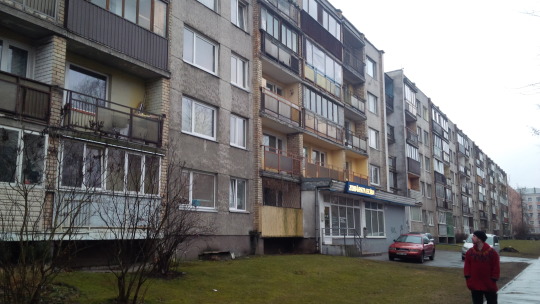

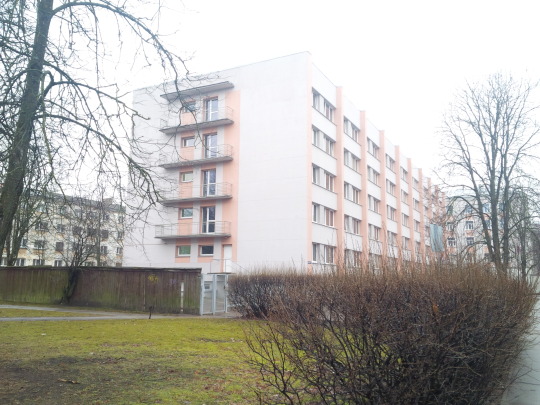



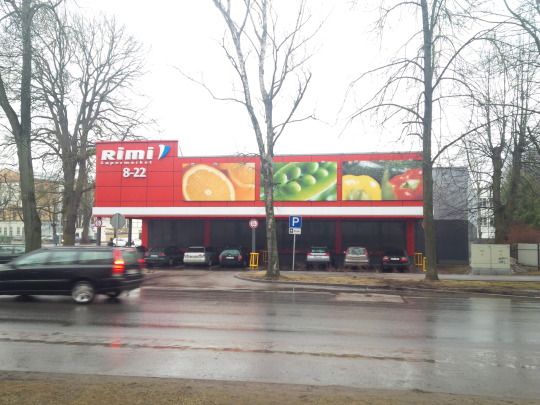
We turned left onto Leipājas iela, where we saw some graffiti that warned us: “beidz izdomāt melus” (stop making up lies). Within a few minutes we were standing outside of Sv. Alberta baznīca, an important part of Rīga’s Catholic community. Originally intended to be built in French Baroque style, starts and stops to the construction resulted in the somewhat unique final design. Across the street behind the brick wall was the many historic buildings on the campus of Stradiņa klīniskā universitātes slimnīca (the university hospital). Unfortunately we did not have the opportunity to explore the campus, but we were so wet and cold at this point that we were ready to take the bus to our final destination: Uzvaras Parks.




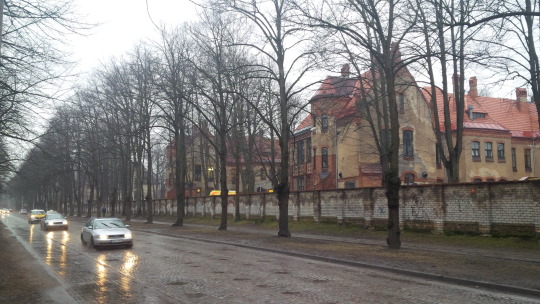
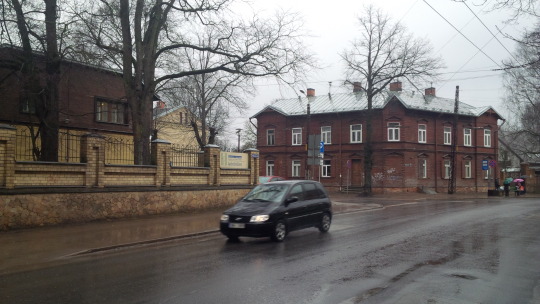
Since turning towards the market, our path had looked like this:

We got off at Slokas iela in front of Zelta Boulings, Rīga’s most popular bowling alley with some of the most surpisringly good pizza found in the city. We backtracked a bit down Uzvaras bulvaris to come to our final stop in the Āgenskalns and one of the city’s most controversial locations: Uzvaras piemineklis (Victory Memorial).

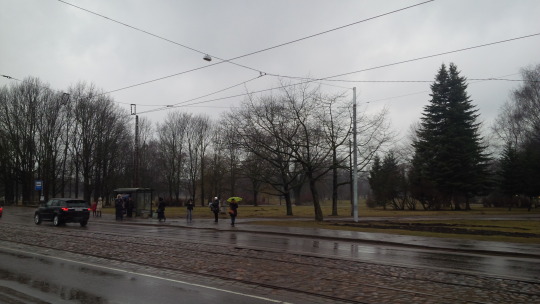

While the end of WWII and the defeat of the Nazis is celebrated throughout the world, many in Latvia (particularly ethnic Latvians) see the end of WWII as the beginning of the Soviet Union’s occupation of the country which included the forced deportations and murders of tens of thousands of Latvians. The monument was built in the early 1980s and is one of the most physically impressive sites in the entire country, but there have been many calls to demolish it as most other Soviet-era statues were at the re-establishment of Latvian independence. In fact, two ultra-nationalists even tried blowing the monument up in 1997, but ended up dying with the statue mostly unharmed. The site is especially important to the city’s ethnic Russian community which makes up nearly a majority of Rīga’s residents, many of whom had family who fought proudly to defend their country against the Nazi invaders. Many ethnic Russians feel alienated and left behind by the Latvian government's policies since 1991 regarding citizenship and language, and removing the statue would inevitably cause significant tension. For the foreseeable future the statue will remain as a divisive symbol which means many things to many people, and I will write more about the issue for the upcoming May 8th/9th celebration of V-E Day. What is undeniable, however, is that the Soviets knew how to make impressive and awe-inspiring statues.








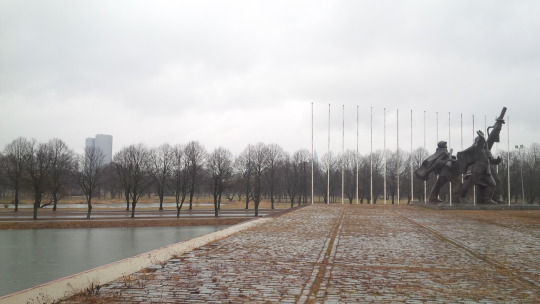

The final part of Āgenskalns that we skipped over was the rest of Uzvaras parks, but we were so cold and wet by now that we decided to go home. Plus, the rain was so heavy by now that the pictures we would have taken wouldn’t have done justice to the beautiful park. Instead, I will cheat with a few pictures we took of the park from last spring.



I hope that these rainy and dark pictures haven’t discouraged you, because visiting Āgenskalns is an absolute no-brainer regardless of your personal interests. While I usually recommend visiting certain neighborhoods to certain people for various reasons, Āgenskalns is one of the only ones I can suggest without any hesitation or second thoughts. If you’ve been in Rīga for any significant amount of time I’m sure you’ve alresdy spent some time here, but if you somehow haven’t yet wandered across the bridge to Pārdaugava then it’s time to come and visit.
A few random observations:
While most people I know who have lived outside of Rīga’s center have told me that they don’t do much in those neighborhoods aside from living and do most other things in the center, most of the people I know who live in Āgenskalns spend a significant amount of their time there. This is unsurprising considering how much there is to do and see here, but it really almost feels like a separate city with a somewhat different feel to it.
That being said, Līga and I have spent surprisingly little time in Āgenskalns. Although there’s so much to do, I have usually seen it from the windows of busses going to and back from work at the LU Pedagogy Faculty in Imanta. From Ķengarags it takes just a tiny bit too long to get to compared to the center where you can find almost anything that Āgenskalns has, but if I already lived in Pārdaugava I’m sure I’d spend more time here than time across the bridge.
Although we thought that winter had just about completely passed at this point in mid-March, we woke up this morning in mid-April to fairly heavy snowfall. To say that winter/spring 2017 has been a curveball would be quite an understatement.
And that’s it for now. I apologize that this post has been a bit longer than the others, but there is just so much to show and talk about in Āgenskalns that I didn’t want to leave anything out. Also a huge special thanks to Konstantin for contributing so much historical information about the neighborhood and its buildings, another reason why this post is a bit longer than the others. He’s planning on coming with us more regularly on our walks through the neighborhoods, and he might contribute some other posts in the future about urban exploration and other Rīga-related topics. Until next time, let’s hope that spring will soon finally stick around!
Nākamā Pietura: Atgāzene!
(Edit: Thanks to Māris Goldmanis from the fantastic Latvian History blog who wrote in with additional information a bout the state archives and the TV tower after the post was first published)
#agenskalns#Āgenskalns#riga#Rīga#Latvia#Latvija#soviet architecture#architecture#art nouveau#latvian history#old riga#Rīgas pilsēta#Vecrīga#Vecriga#water tower#city exploration#urban exploration#urbanexploration#urban explorers#urbandecay#abandoned buildings#abandoned places#Рига#Pārdaugava#riga stradiņš university#z-towers#uzvaraspiemeneklis#uzvarasparks#Латвия#public transit
2 notes
·
View notes
Text
Houses For Sale in Excelsior, MN
27665 Brynmawr Pl, Excelsior, MN
Price: $759000
A breathtaking, newly remodeled home with stunning features! Updated main level with gorgeous kitchen, beautiful vaulted family room with large windows overlooking the private, nearly one acre backyard. Amazing woodwork and details throughout the home. You’ll find a large master suite, main floor office with fireplace, fabulous walkout lower level and so much more. Located on a beautiful cul-de-sac in a fantastic neighborhood! Close to parks, trails and walk to Howards Point Marina., Directions Smithtown to Howards Point Rd West to Brynmawr
3966 Linden Cir, Excelsior, MN
Price: $239900
Adorable Twin Home Just Minutes to Downtown Excelsior and Located in the Award Winning Minnetonka School District. Private Beach Access on Lake Minnewashta! Home Features Large Eat In Kitchen, Family Room Overlooking Patio & Wooded Backyard. Main Floor Half Bath & Laundry. Three Bedrooms on One Level with Walk Through Master Bath. Located in a Residential Neighborhood. Close to Trails & Easy Access to Hwy 7 and Hwy 5. Quick Close Possible, No Rental Restrictions., Directions -Take either Hwy. 5 or Hwy. 7 West to Minnewashta Parkway – South to Linden Circle
5935 Lake Linden Ct, Excelsior, MN
Price: $999000
Perched on a hill, this former Parade Home offers the highest quality in design and finish detail. Classic millwork with purposeful built-ins and fine finishes on every surface. The large windows, rustic screen porch and large front porch bring a casual elegance to the more classic details. Upstairs, 4 bedroom suites await. A spacious walkout level can be converted to In-Law suite with a private entry and 2 car garage. Tons of storage, Spacious yard area; 1 mi to Excelsior lakefront; Mtka Sch.
4051 Leslee Curv, Excelsior, MN
Price: $364900
A must see property in the Minnetonka school district! Beautiful vaulted ceilings, open floor plan, updated and super clean! Minnetonka High, MMW, Minnewashta Elementary. Large lot, great location, with huge 3 car garage and concrete driveway.
2650 Kelly Ave, Excelsior, MN
Price: $489000
Beautiful family home just steps from Lake Minnetonka. With .5 acres & 5 bedrooms, this home will accommodate the family of any size. two master suites with private baths. Kitchen includes granite countertops, breakfast bar, & stainless steel appliances. Cozy family room adjacent to kitchen features recessed lighting and gas fireplace. Recent updates including new carpet in 2017, furnace and A/C in 2016, electrical in 2015, & exterior paint in 2016. Rare opportunity in high demand neighborhood!
117 Pleasant Ln E, Excelsior, MN
Price: $499000
DESIRE a home with spacious rooms, a private cul-de-dac lot, exceptional spaces to entertain and a possible Boat slip on Mtka thru the City? Then see this 3+ brm that features a huge master brm , main flr den, open floor plan, 2 porch’s, plus an expansive lower level that will accommodate large gatherings w/wet bar & game rm. All meticulously maintained – lots of updates, hardwood floors, 2 hi-efficiency furnaces, Minnetonka schools & much more- See photos for details-then grab it B4 it’s gone!
2570 Lydiard Ave #72, Excelsior, MN
Price: $369900
Great side by side duplex in demand single family neighborhood. Walk to quiet beach on Lake Minnetonka, grocery store, restaurants and more. Great wooded lot with mature trees. This property would be great for an owner occupant.
1820 Pheasant Dr, Excelsior, MN
Price: $289900
Welcome home to this charming one-level living home on a nice lot in excelsior. open layout, stone fireplace in living room, formal dining, main floor laundry and breakfast area in the kitchen. 3 main floor bedrooms and private full master suite with walk in closet. Natural woodwork throughout plus new floors and fresh paint. Living room walks out to deck and backyard and full basement awaits your finishing touches. Check out virtual tour!
5955 Boulder Bridge Ln, Excelsior, MN
Price: $950000
Modern architecture and a refreshing sense of style make this pristine home a must see! Enjoy the many amenities that Boulder Bridge offers including, a dock slip on Lake Minnetonka, beach access, a trail and tennis courts. Situated on a private 1 acre tree-lined lot with pond views near the end of a cul-de-sac, this home offers main level living and many updates. They include a remodeled master bathroom, kitchen and family room area with new cabinets, countertops, appliances, backsplash and fireplace.
5590 Manitou Rd, Excelsior, MN
Price: $389900
Newly updated end unit twinhome situated on private wooded lot. Open floor plan with soaring vaults, granite counters, stainless steel appliances, 2 gas fireplaces, huge walkout lower level with built in bar, four seasons porch with deck, private master bath with separate tub. Walk to shopping and restaurants. Close to Excelsior and trail system.
5300 Eureka Rd, Excelsior, MN
Price: $225000
Opportunity to build dream home in Shorewood near Lake Minnetonka! Large .35 acre lot w/mature trees for privacy. Home on the lot is livable, but has foundation issues-repair or tear down and start from scratch. Located within the Minnetonka school district. Close access to Highway 7, parks and more! Blocks from the beach and Lake Minnetonka Regional Trail.
27755 Woodside Rd, Excelsior, MN
Price: $650000
Main Floor living, on a beautiful demand lot in Shorewood. Open floor plan with a bright great room feel. Southern exposure and perfect for entertaining. Lovely master suite. The walkout lower level features 3 bedrooms, a wet bar and family room area. Oversized garage and on a quiet street near lake Minnetonka, beaches and trails.
19475 Vine Ridge Rd, Excelsior, MN
Price: $445000
Well maintained 5 bedroom/ 4 bath home on Vine Ridge with gorgeous wetland views! 4 beds up! Master has large walk in closet and large en suite with separate tub and shower. Updated kitchen with new cabinets, appliances, and granite. Wood burning fireplace in the family room off the kitchen and a gas burning in the lower level family. Lower level is a walk out which also has a 5th bedroom and 3/4 bath. Great neighborhood with community social events.
4000 Glendale Dr, Excelsior, MN
Price: $385000
Welcome home! This is the renovated home you've been waiting for. Every surface has been touched! Move right in to this masterpiece. Open concept design provides a modern lifestyle. The kitchen has exactly what you want with Espresso cabinets, Quartz countertops, stainless appliances, and enough space to feel comfortable. Spacious master bedroom with 2 large closets. Large garage, with additional lower level 24×23.5 garage with backyard access. Neighborhood beach access to Lake Minnewashta.
1661 Wood Duck Ln, Excelsior, MN
Price: $509000
Exquisite home nestled in the rolling hills on a huge corner, Cul-De-Sac lot. Close to downtown Excelsior, 1/2 block to park/walking trails. 3+ garage. Beautifully updated/maintained home. Elegant remodeled kitchen w/ modern white cabinetry, granite countertops, and SS appls. Hardwood flrs, brick fireplace and custom built-ins. Formal/ informal living and dining. 4 bedrms up. Luxury Master Suite w/dual closets, private bath w/new tile. Spacious LL Family Room retreat, game area, room to grow!
1610 W 63rd St, Excelsior, MN
Price: $345000
Wonderful rambler on 1/2 acre nestled in between downtown Excelsior and Downtown Chanhassen. Amazing detached 3 car garage ideal for the hobbyist and tinkerer. Master suite features walk-in closet, large master bath with dual vanities. Open family room boasts beautiful stone fireplace. Lower level has 2 more bedrooms and a 3/4 bath, family room area and separate entrance.
6420 White Dove Dr, Excelsior, MN
Price: $419900
Four Bedroom Upstairs Two Story Walkout on a pond in Minnetonka Schools! Several rooms have fresh paint. Main level has new carpet. New granite countertops and subway tile in kitchen. Hardwood floors. Sellers added the wonderful sunroom on the main level and downstairs. Siding replaced in 2009. Maintenance-free deck 2014. Furnace and a/c 2014. Water softener 2015. Garage heater 2013. Gutter Helmet 2013. Rough-in for a bathroom in the lower level. Large unfinished storage space downstairs., Directions GALPIN BLVD TO PHEASANT TO WHITE DOVE DR TO HOME
19735 Chartwell Hl, Excelsior, MN
Price: $795000
Terrific Waterford neighborhood home with amazing living spaces and great south facing views with wooded rear yard. Vaulted, high ceilinged main level includes center island kitchen with large pantry, adjoining family room and screened porch. Main level master suite and laundry. Extensive decking. 3 Bedrooms on second floor. Walkout level includes extensive amusement room, plus surprising in-law suite with bedroom, bath, living area with mini-kitchen.
4761-4763 Manitou Rd, Excelsior, MN
Price: $425000
Nice 3 bedroom side by side close to downtown Excelsior and Lake Minnetonka. Great for owner occupant or easy to keep rented. Property has had many upgrades.
19735 Near Mountain Blvd, Excelsior, MN
Price: $450000
Award Winning Minnetonka Schools. Beautiful 2 story home in wonderful neighborhood. This 4 bedroom 3 bathroom home is located on a cul-da-sac. Finished basement. Enjoy the 12×12 porch. Master bedroom with master bath. A must see!
from http://www.theochomesearch.com/houses-for-sale-in-excelsior-mn/
0 notes
Text
0 notes
Text
0 notes